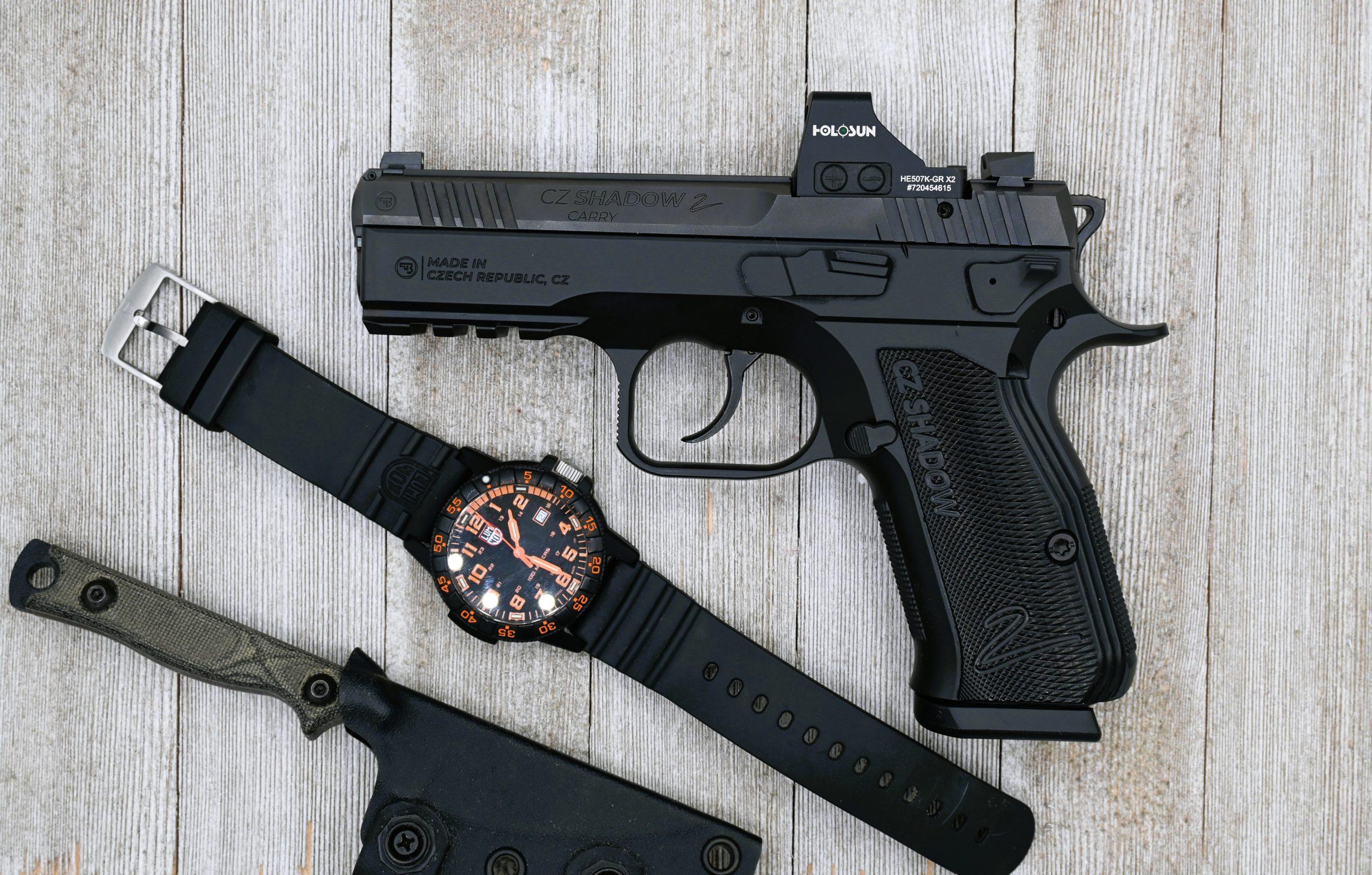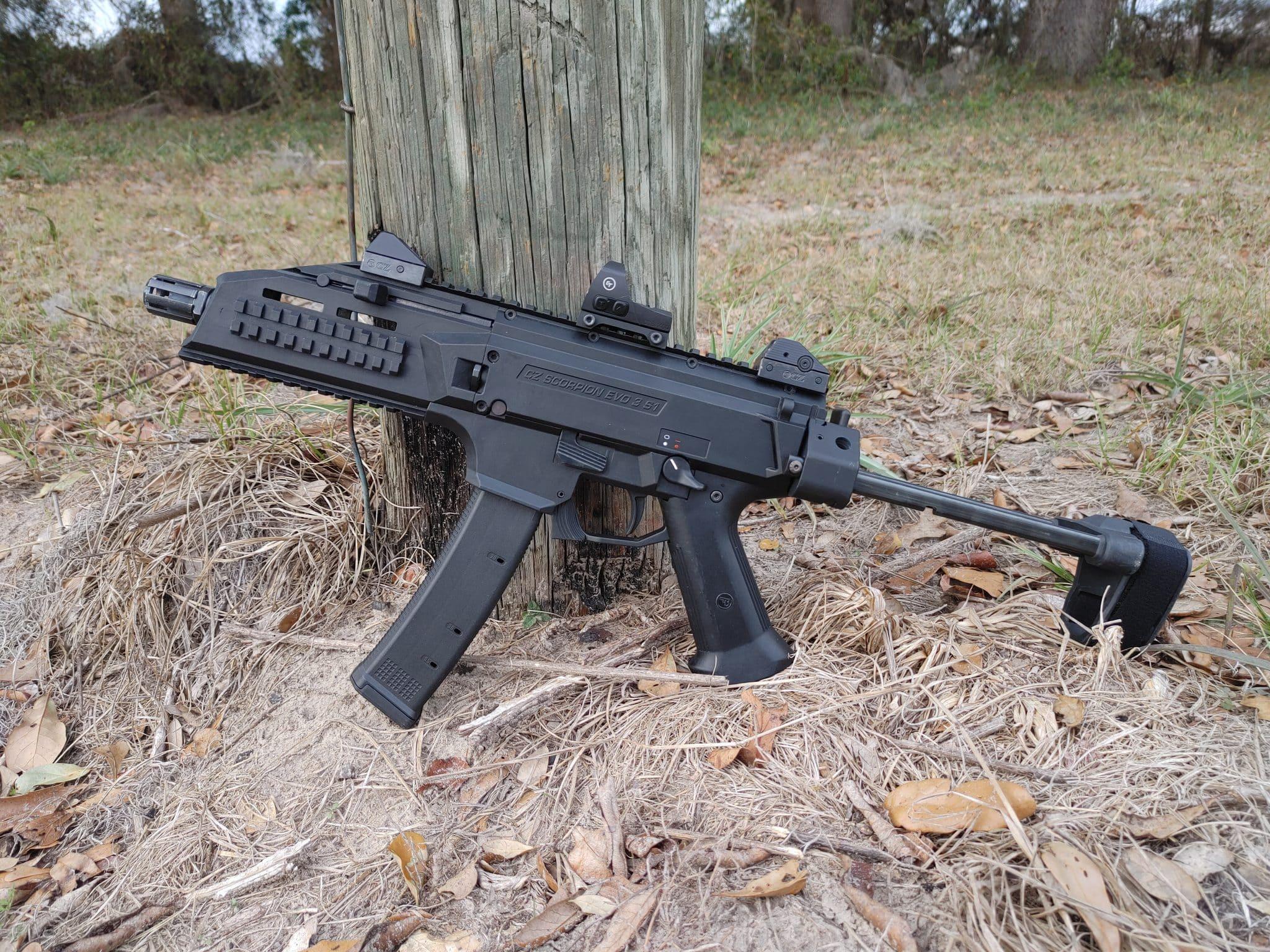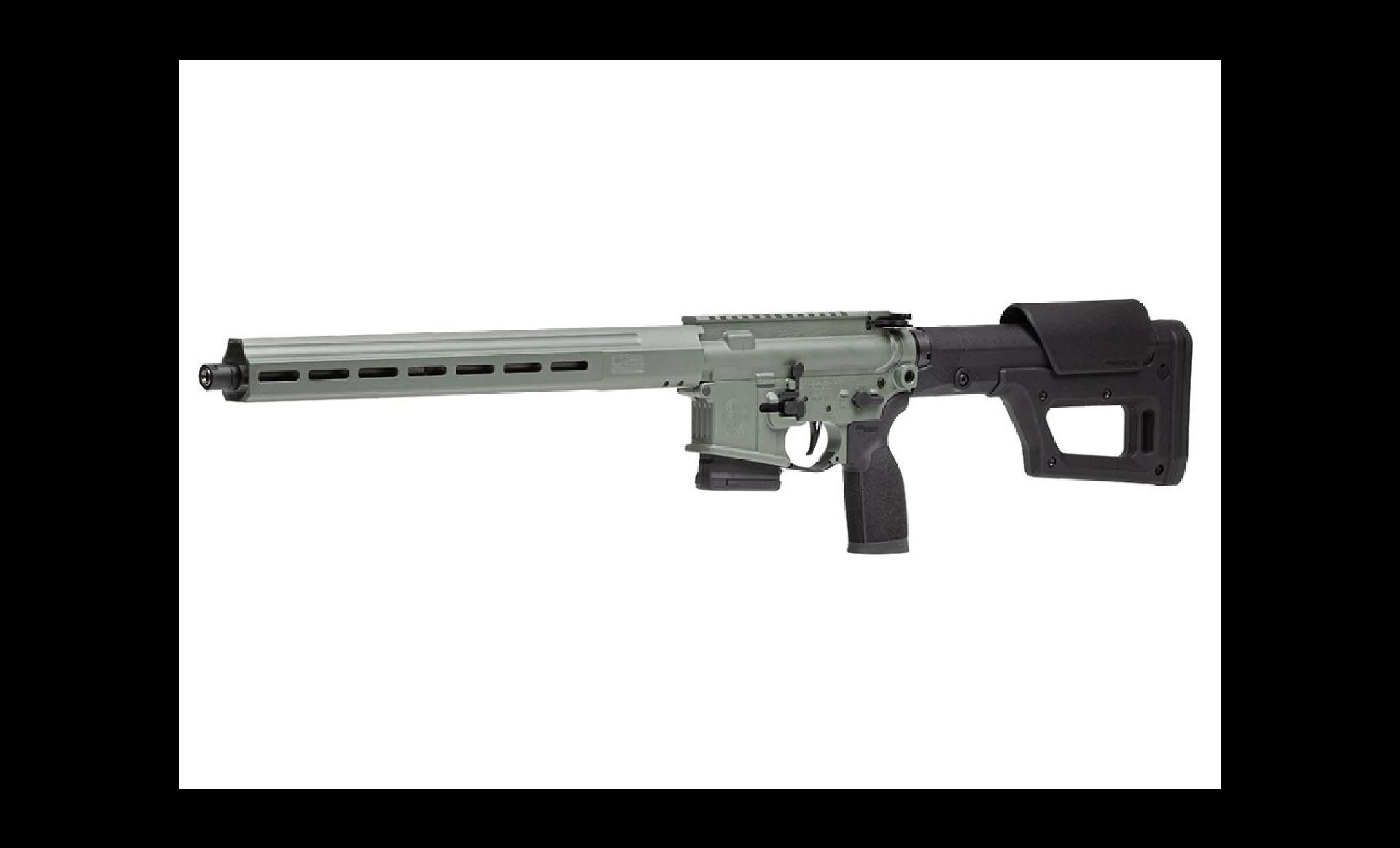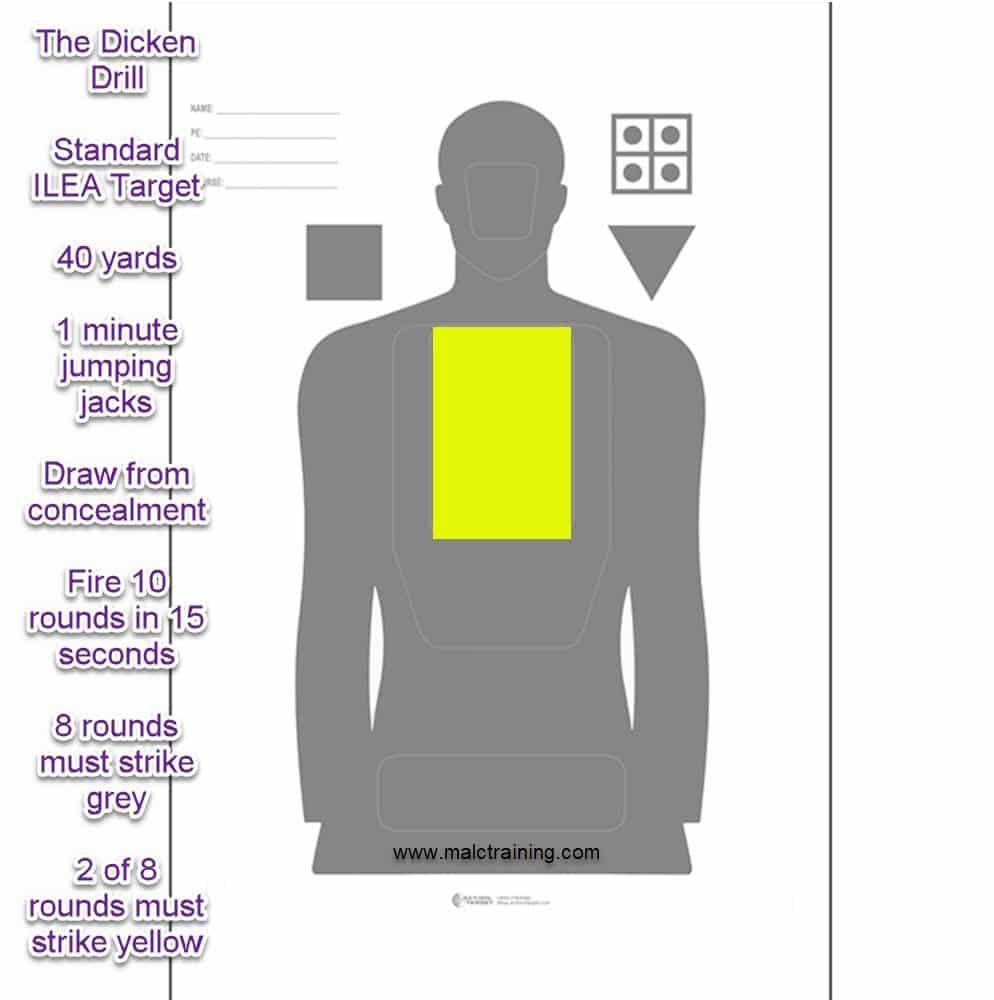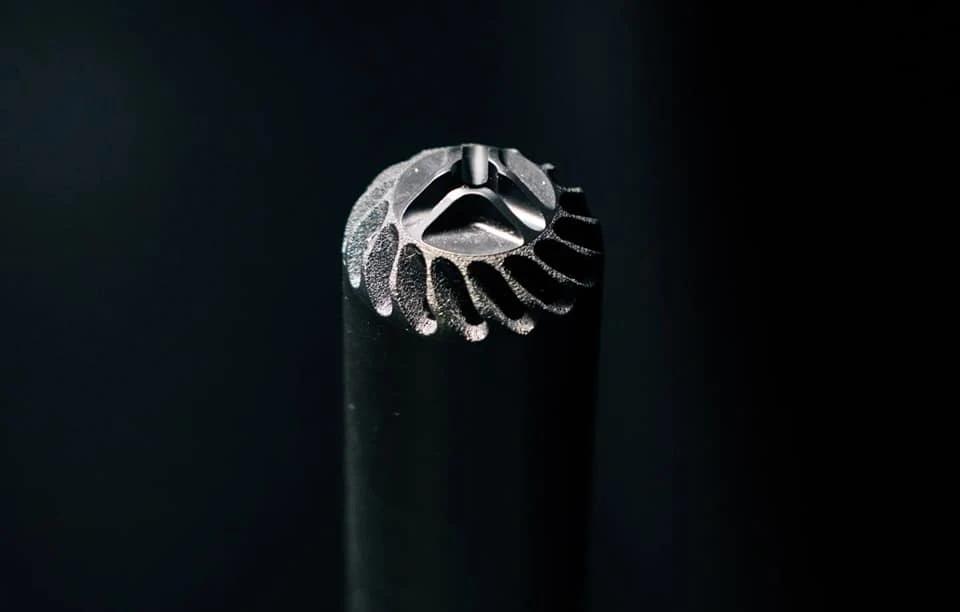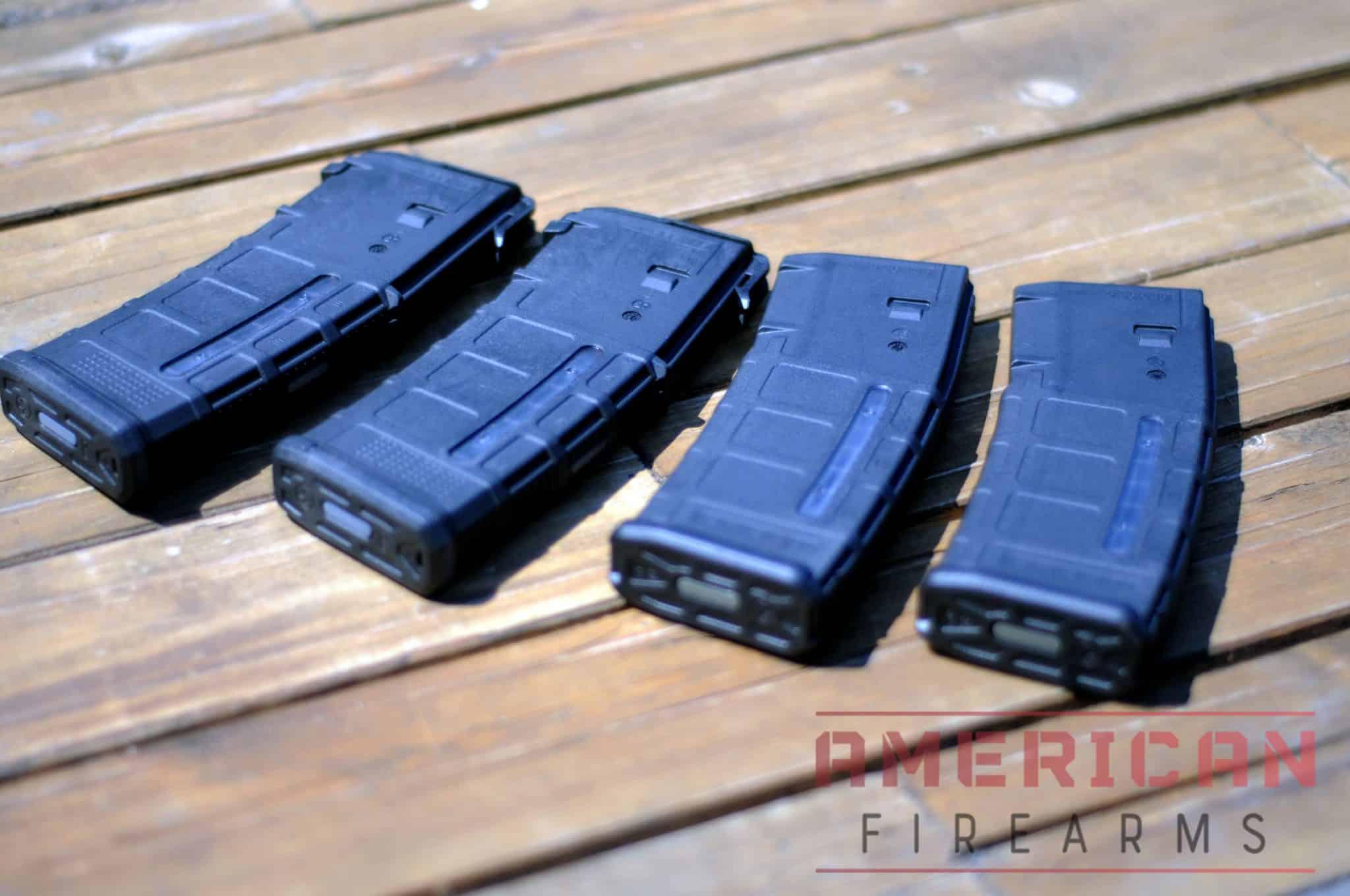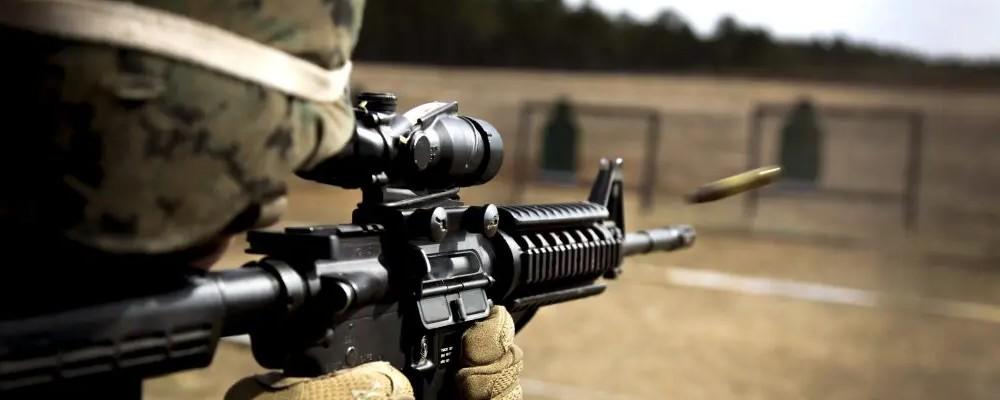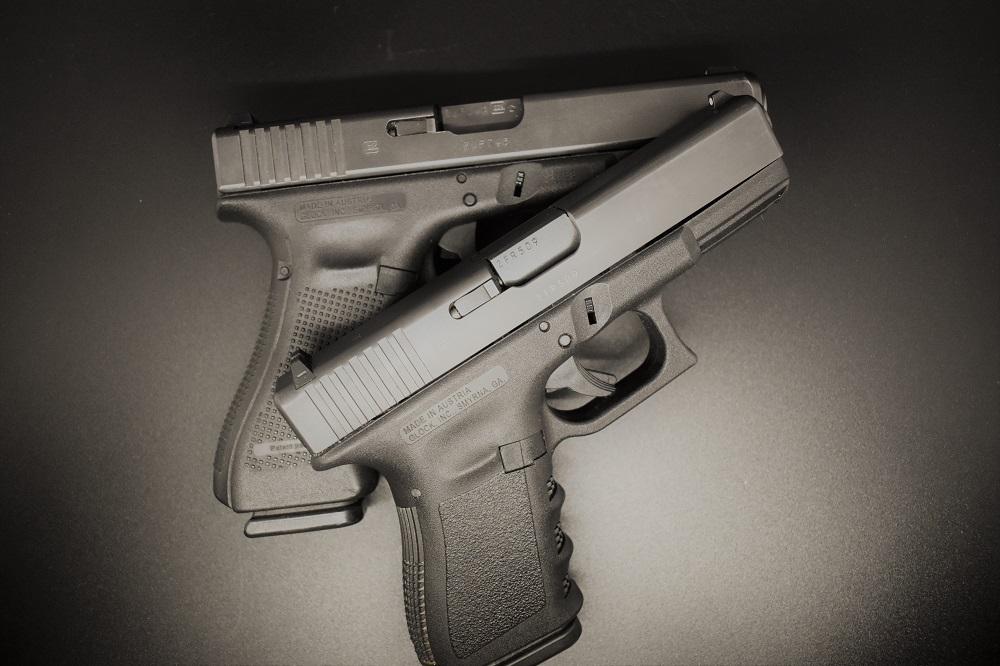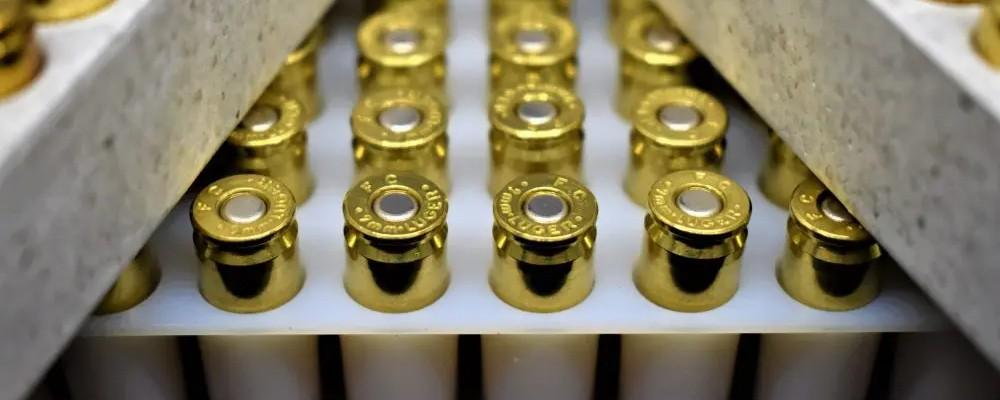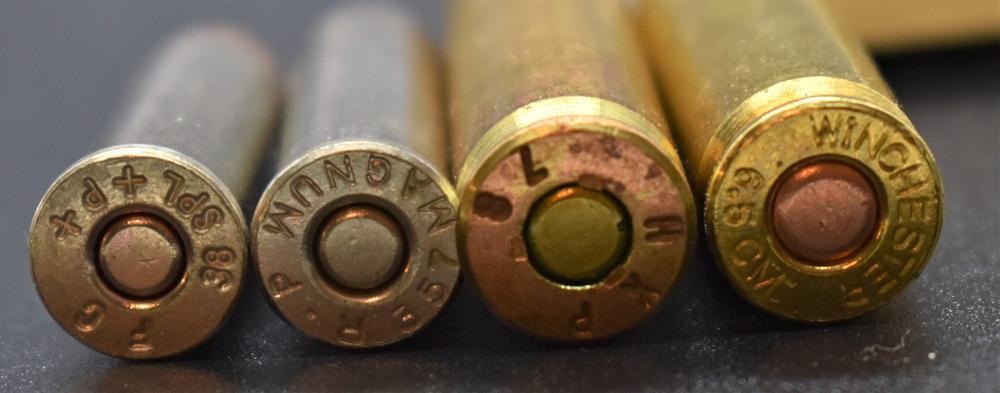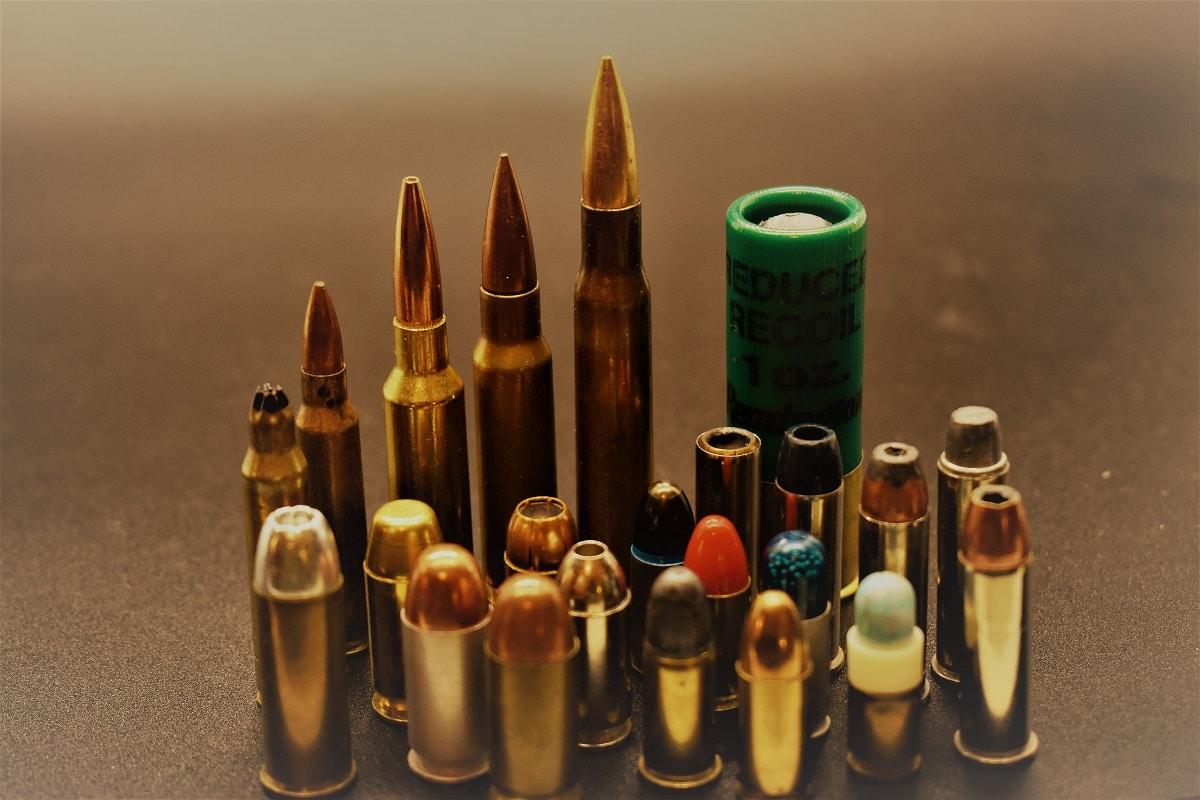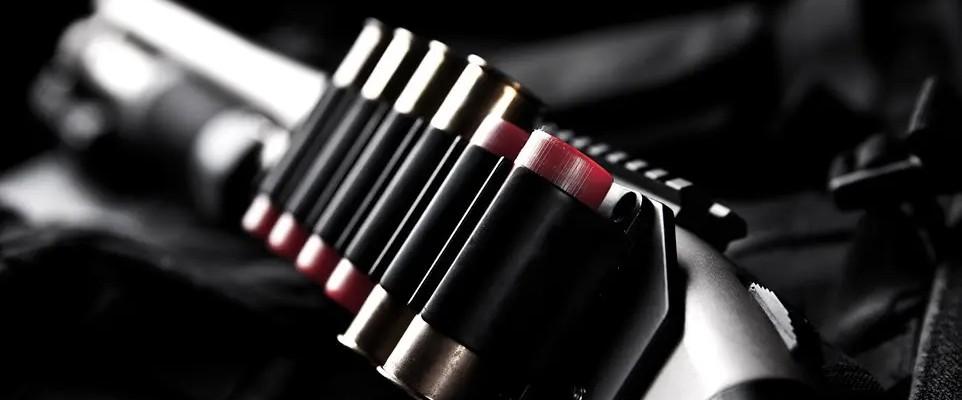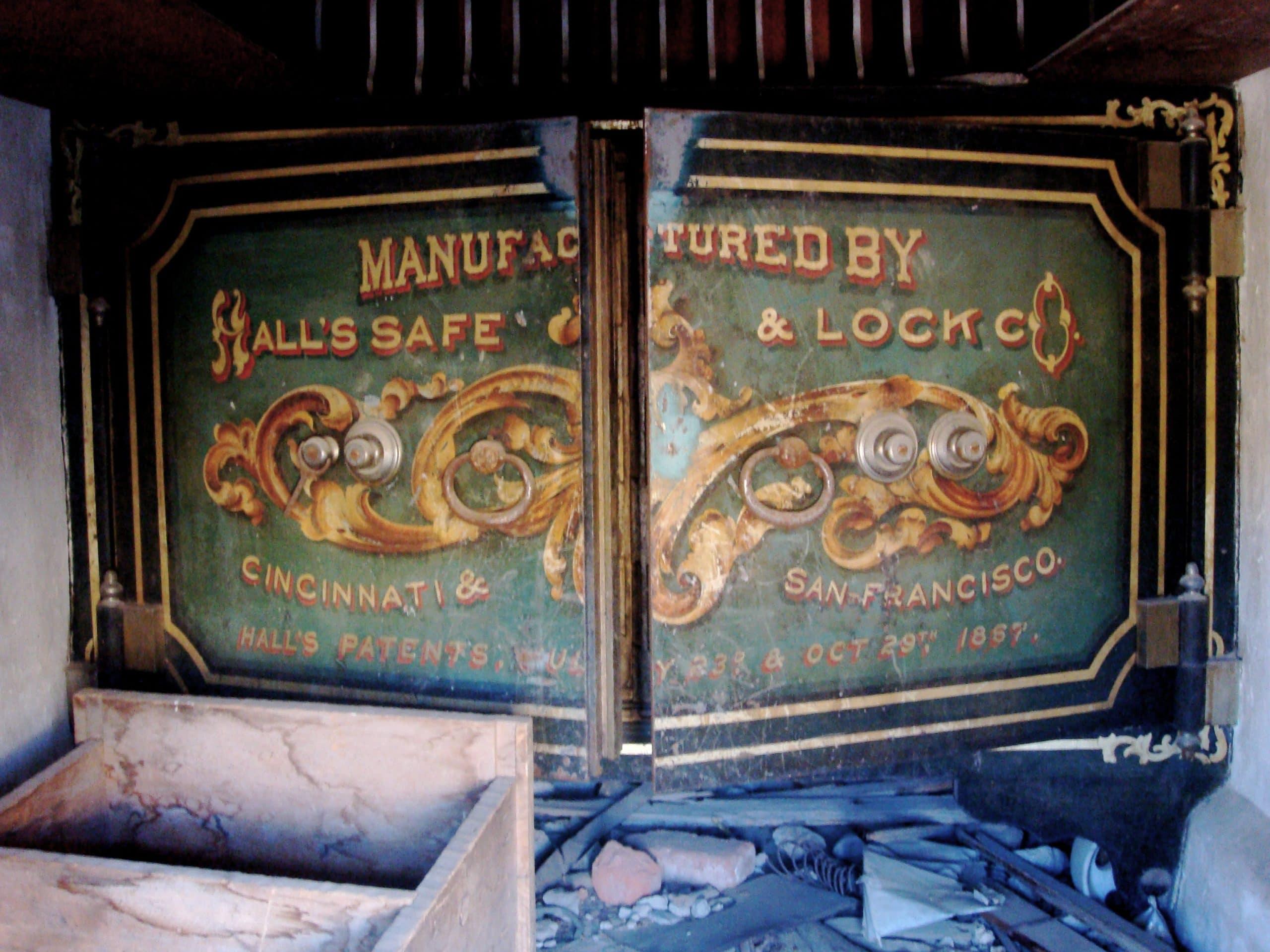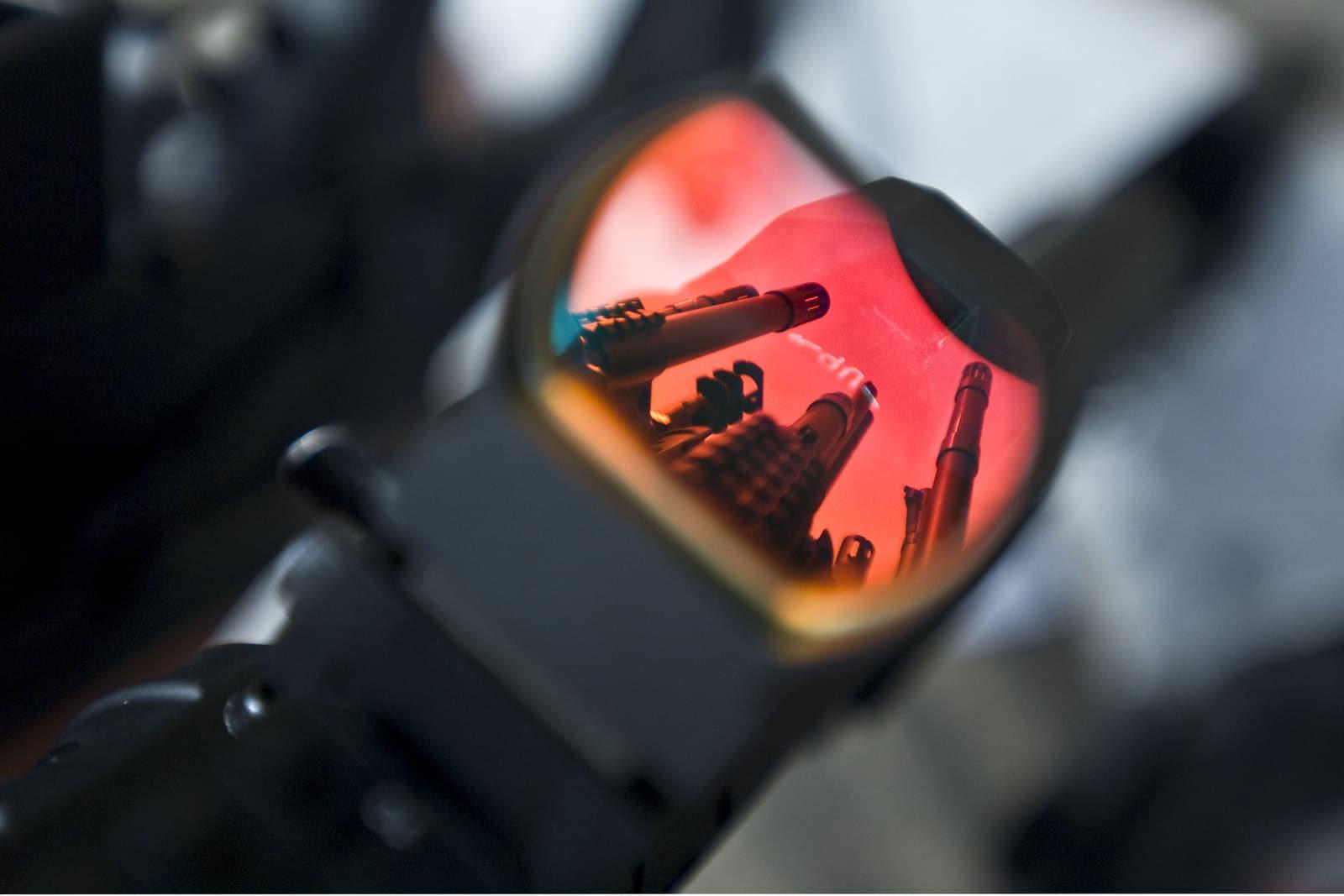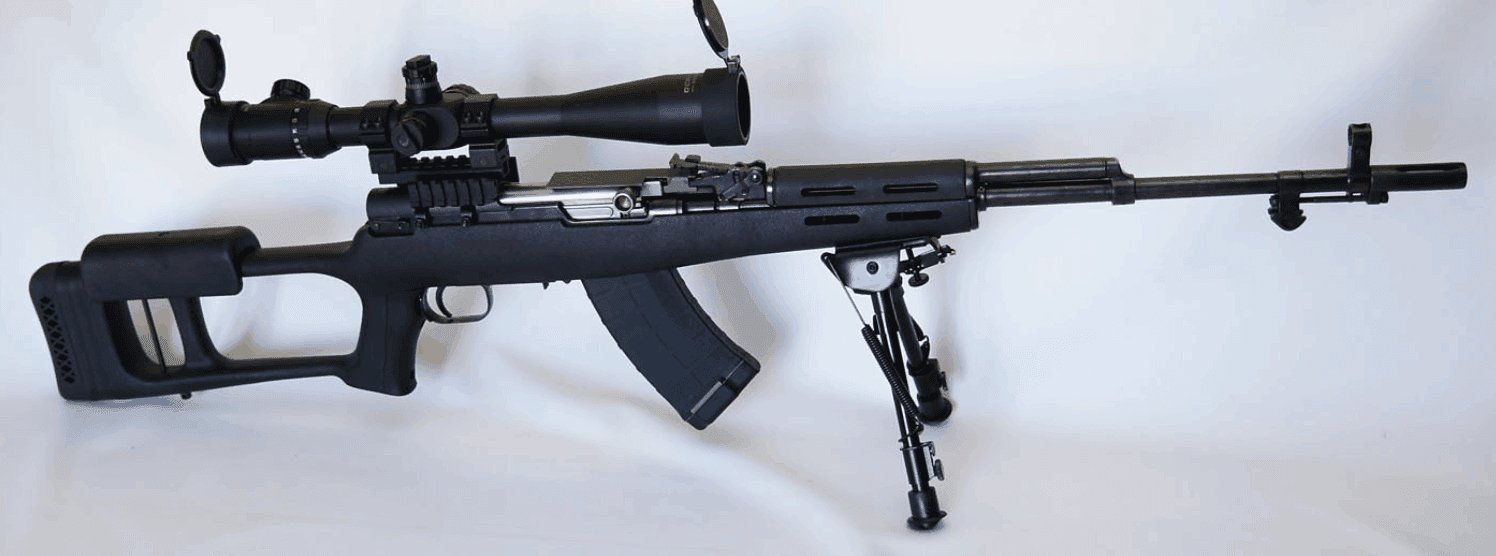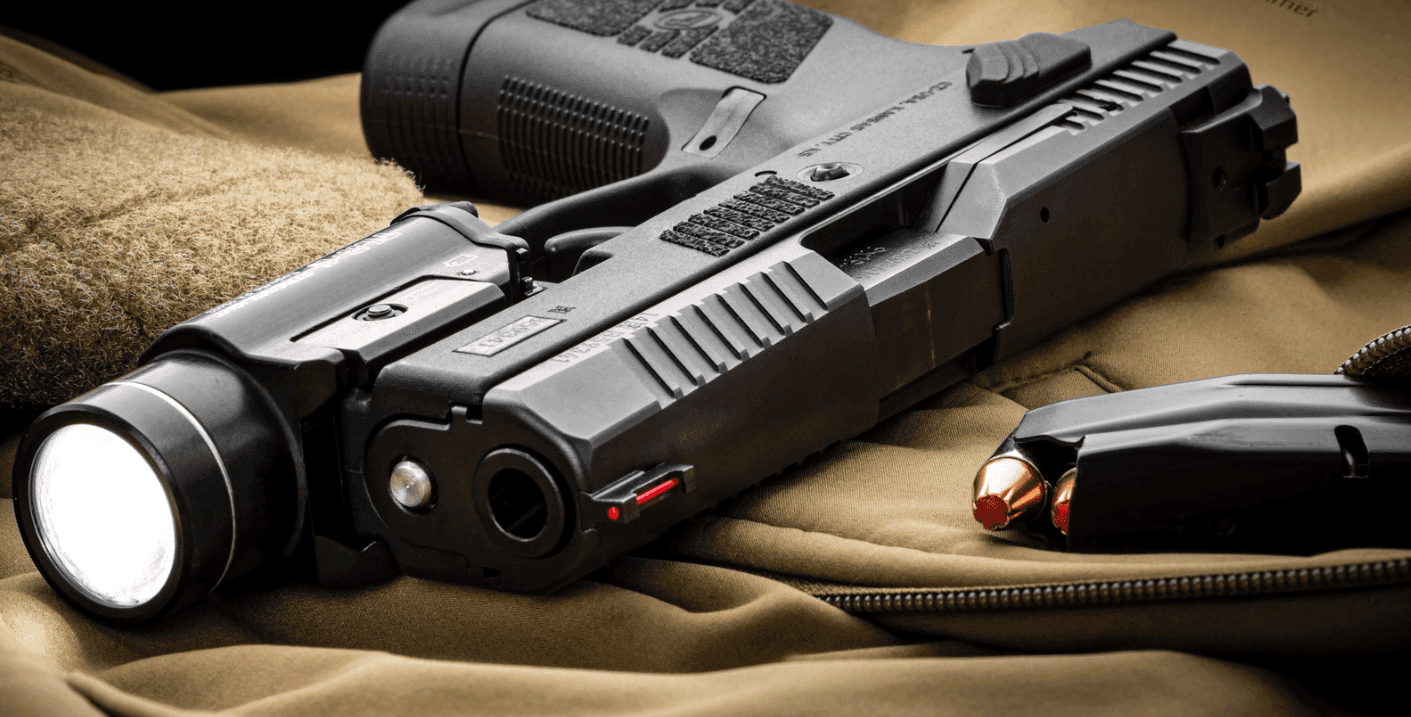Best Handguns for Women: 6 Picks for Any Scenario
What makes a handgun work well for a female shooter? Here's our top handgun recommendations and guidance on how to get it right.
Written By
Elizabeth Bienas
Licensed Concealed Carry Holder
Edited By
Michael Crites
Licensed Concealed Carry Holder
Share:
Products are selected by our editors. We may earn a commission on purchases from a link. How we select gear.
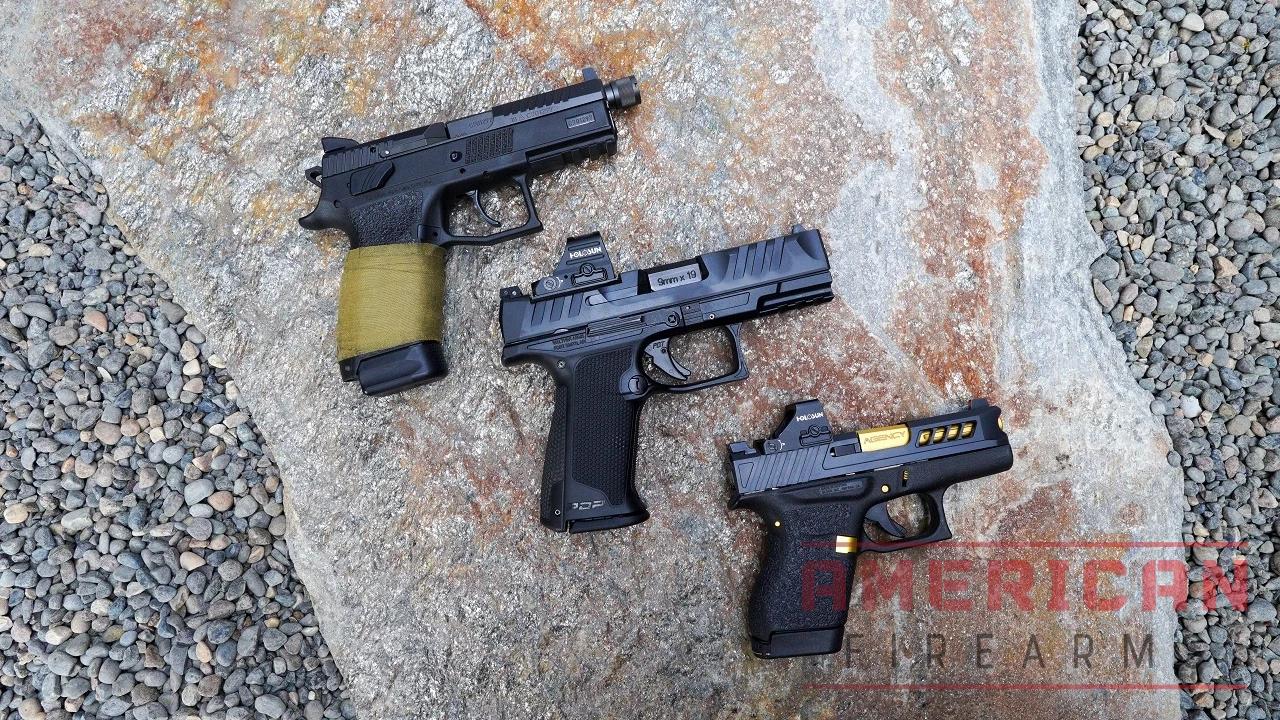
Updated
Aug 2025
The best handgun for a woman is one she can shoot accurately, handle comfortably, and, if she wishes, conceal easily. No single choice will satisfy all these factors for all women. As with men, finding the right pistol is a process. And as we look for “the one,” it helps to have a jumping-off point.
In this article, I will walk you through some key factors to consider when choosing your first, third, or even tenth handgun. I will also give you a list of pistols that are popular with women in case you’re unsure where to start. Let’s dive and look at the top handguns for women in various categories.
In This Article
Quick Comparison
| Model | Grip Fit | Concealability | Recoil Management | Ease of Use | Capacity |
|---|---|---|---|---|---|
Excellent | Good | Excellent | Excellent | 15+1 | |
Good | Excellent | Good | Good | 6+1 | |
Good | Very Good | Good | Good | 10+1 | |
Very Good | Very Good | Good | Good | 12+1 | |
Good | Very Good | Very Good | Excellent | 8+1 | |
Very Good | Poor | Excellent | Good | 18+1 |
How We Test
Ergonomics & Fit
We evaluate how each handgun fits different hand sizes, particularly focusing on trigger reach, grip circumference, and control accessibility.
Shootability & Accuracy
We fire four 5-round groups from a bench rest at 15 yards (reduced from 25 yards to better reflect defensive distances) and measure groupings for consistency.
Concealability
We test each handgun’s concealment effectiveness across multiple carry positions (AIWB, strong-side hip, off-body) using various holster types and clothing styles typical for women.
Reliability & Function
We fire one full magazine each of FMJ and hollow point ammunition, monitoring for feeding, firing, and ejection issues.
More on Our Testing Process
Factors to consider
Intended Use

When shopping for a firearm, the first step is to determine the primary use. Doing this upfront will save a lot of time. Will you carry it concealed, or is it strictly for home defense? Do you shoot competitively, or are you considering it? Of course, uses can overlap, but focus on how you’ll use it most.
Size Matters
There’s a long-standing myth that smaller firearms are the only choice for women. That’s simply not true. Women can shoot all sizes of pistols, and ultimately, their choice will come back to intended use first.
For example, if you’re shopping for a concealed carry pistol, you may think tiny is the only way to go. And if you’ve got a very petite frame, that may be true. On the other hand, I have several tall female friends who conceal a compact size daily.
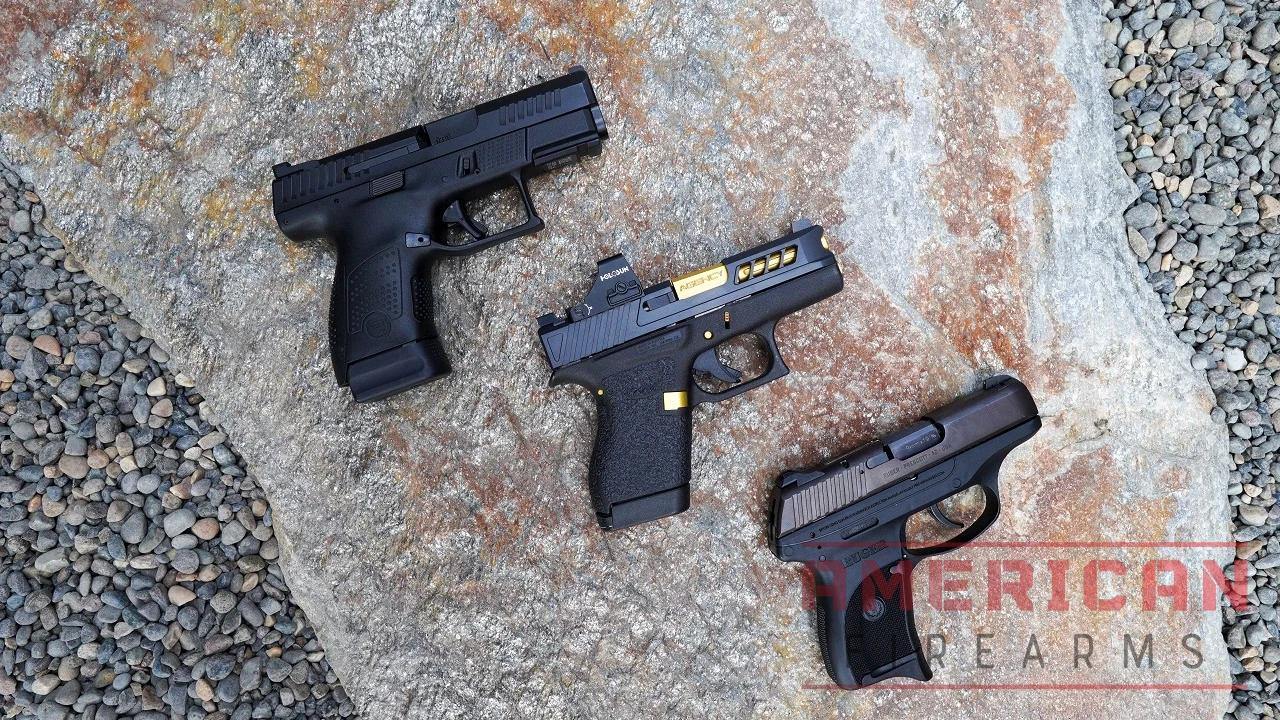
My general rule is that you should carry the largest handgun you can easily conceal and shoot well. For some of us, that means a Sig P365; for others, it’s a Glock 19. Concealed carry is one area where compromises will likely be necessary, and that’s ok.
On the other hand, if you are searching for a match gun for competitive shooting, you wouldn’t choose a Glock 43. Competition guns are bigger and heavier and probably not something you’ll carry concealed.
While we’re on the subject of size, hand size is an essential factor to consider. If a gun is too big and you can’t get a full grip or reach the trigger, you won’t shoot it well. Alternatively, you may struggle to grip a small gun if your hands are large.
Capacity
While we’re talking about size, let’s consider magazine capacity. Generally speaking, the smaller the pistol, the fewer rounds you can carry. Until recently, if you wanted to carry more rounds, you’d have to opt for a large gun or carry extra magazines.
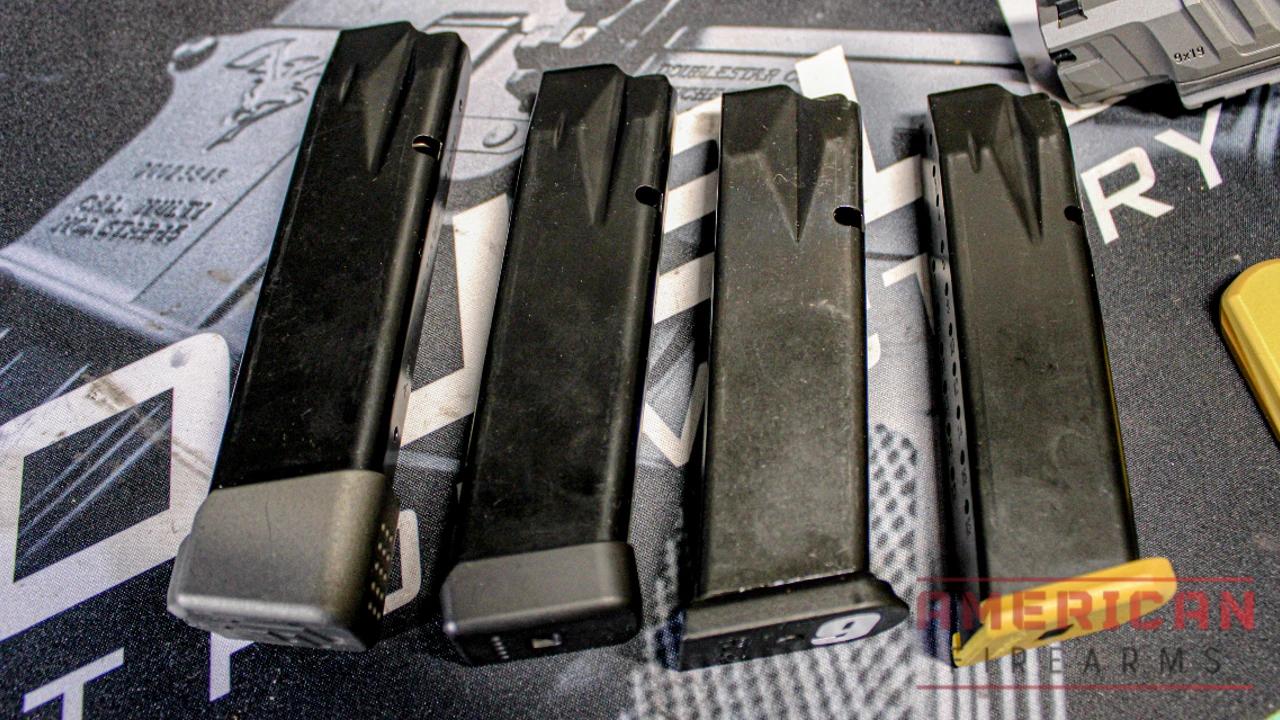
Manufacturers are figuring out ways to get 12+1 into a micro-compact, though, and that’s a big deal, especially for concealed carry. Be aware that more rounds will add a bit of overall weight.
Caliber
Another myth that needs busting is that all women should learn to shoot on a .22 LR. Not every woman needs a small, soft-shooting round to learn. Of course, if factors like reduced hand strength warrant the .22, something is better than nothing.
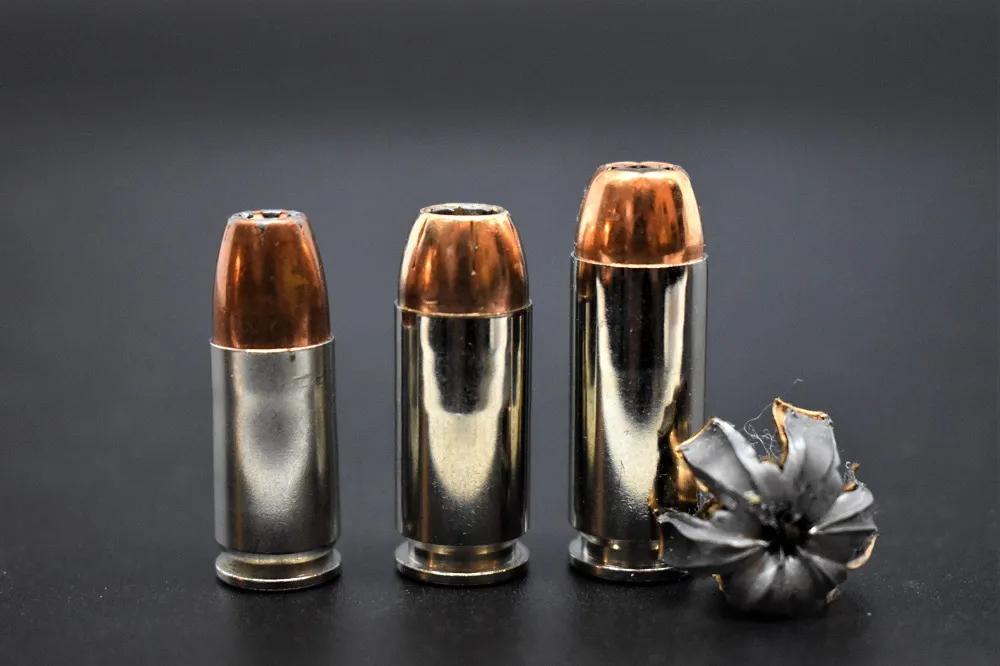
Most agree that .22 is not powerful enough to stop an attacker. If you intend to carry it someday, 9mm is an excellent caliber, as it’s likely what you’ll carry. I believe that any gun is better than no gun, but don’t let anyone convince you that 9mm is too powerful for you.
Revolver vs. Semi-Automatics
There’s an old-school mentality in some gun shops that women should automatically start with a revolver. “It’s simpler,” they’ll say, or “you don’t have to worry about jams.” I’ve heard this advice countless times, and while revolvers certainly have their place, this one-size-fits-all recommendation drives me crazy.
The truth is, both revolvers and semi-automatics have distinct advantages and disadvantages for female shooters. The right choice depends entirely on your specific needs, physical capabilities, and intended use. Let me break down the real differences so you can make an informed decision.
The Case for Revolvers
I’ll start with what the gun shop guys get right: revolvers are mechanically simpler. There’s no slide to rack, no magazine to load under spring tension, and no complex manual of arms to memorize. Point, pull trigger, bang. If it doesn’t fire, pull the trigger again – the cylinder rotates to a fresh cartridge automatically.
This simplicity can be especially valuable for someone with limited hand strength or dexterity issues. My friend’s 70-year-old mother carries a lightweight .38 Special revolver specifically because she can’t rack the slide on most semi-autos. For her, the revolver’s simplicity isn’t just convenient – it’s essential.
Revolvers are also incredibly reliable in the sense that they’re less sensitive to ammunition types and less prone to user error. There’s no “limp wristing” with a revolver, no worries about riding the slide stop, and no concern about proper grip technique affecting function.
The Reality Check on Revolvers
Here’s what those gun shop recommendations often gloss over: revolvers aren’t necessarily easier to shoot well. That double-action trigger pull – especially on lightweight revolvers – can be brutally heavy. I’m talking 12-15 pounds of trigger pull versus 4-6 pounds on most semi-autos.
Massad Ayoob, one of the most respected firearms instructors in the country, has written extensively about this issue. A heavy trigger pull doesn’t just make accuracy harder – it can actually make the gun less safe in the hands of someone who has to use both hands and their whole body to pull that trigger.
I learned this lesson personally when I tried my first snub-nose .38. I was amazed at how much the muzzle moved during that long, heavy trigger pull. Compare that to the crisp, light break on something like the Walther PDP-F, and you’ll understand why many female competitive shooters prefer semi-autos.
Semi-Automatic Advantages
Modern semi-automatics offer several advantages that make them appealing for many women. First, capacity: most carry-sized semi-autos hold 10-15 rounds compared to 5-6 in a revolver. That’s a significant difference if you ever need to defend yourself.
The ergonomics are often better too. Semi-autos can be designed with adjustable backstraps, different grip textures, and controls positioned for smaller hands. Companies like Walther have spent considerable engineering effort creating guns that fit female shooters better.
Reloading is typically faster and easier with semi-autos. Dropping a magazine and inserting a fresh one is much simpler than fumbling with a speed loader or loose cartridges, especially under stress.
The Learning Curve Reality
Let’s be honest about the complexity issue. Yes, semi-autos have more steps to learn initially. You need to understand how to load the magazine, rack the slide, engage any safeties, and perform basic malfunction clearances. But here’s the thing: once you learn these skills, they become second nature.
Julie Golob, the accomplished competitive shooter and former Army Marksmanship Unit member, often points out that women tend to be excellent students who master technical skills quickly when properly taught. Don’t let anyone convince you that semi-autos are “too complicated” for women – that’s patronizing nonsense.
| Factor | Revolvers | Semi-Automatics |
|---|---|---|
Simplicity | Very simple operation | More complex initially |
Capacity | 5-6 rounds typical | 10-15+ rounds typical |
Trigger Pull | Heavy (10-15 lbs) | Light (4-6 lbs) |
Reliability | Very reliable | Reliable with proper maintenance |
Reloading Speed | Slow | Fast |
Concealment | Cylinder creates bulk | Generally thinner profile |
Maintenance | Minimal | Regular cleaning needed |
Learning Curve | Minimal | Moderate |
Physical Considerations
Here’s where individual factors really matter. If you have arthritis, limited grip strength, or dexterity issues, the calculation changes. Some women find it easier to pull a heavy revolver trigger than to rack a semi-auto slide. Others find the opposite – that the slide manipulation is easier than managing that long, heavy trigger pull.
Hand size plays a role too. Very small hands might struggle with the grip circumference on double-stack semi-autos but feel comfortable with a revolver’s grip. Conversely, larger hands might find snub-nose revolvers too small to control effectively.
My Recommendation
If I had to give general advice, I’d suggest that most women start by trying both types. Rent a quality revolver like the Ruger LCR and a good semi-auto like the Glock 19 or Walther PDP-F. Shoot them both and see which feels more natural.
Pay attention to your accuracy with each, how comfortable you are manipulating the controls, and how confident you feel operating each gun. Don’t let anyone else make this decision for you based on outdated assumptions about what women “should” carry.
That said, if I’m being completely honest, I lean toward recommending semi-autos for most female shooters. The capacity advantage, easier trigger management, and faster reloading typically outweigh the simplicity benefits of revolvers. But that’s my bias based on my experience – your mileage may vary.
The “women should carry revolvers” stereotype needs to die. Some women will prefer revolvers, others will prefer semi-autos, and both choices can be perfectly valid. The key is making an informed decision based on your specific needs, capabilities, and preferences – not on what some gun shop employee thinks is appropriate for your gender.
Whatever you choose, commit to proper training and regular practice. A revolver in the hands of someone who’s trained with it will always be more effective than a semi-auto that sits unused in a safe. The best gun is the one you’ll actually carry and know how to use effectively.
Top Handguns for Women by Category
1. Best Overall: Walther PDP-F
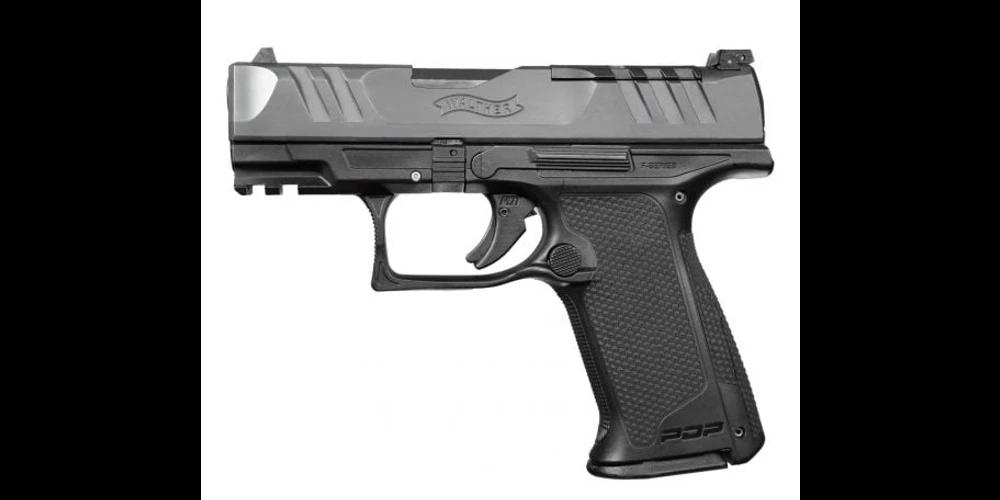
$672.99

50
EXCEPTIONAL
Performance Scores
The Good:
- Reduced trigger reach for small hands
- Crisp, clean trigger break
- Soft recoil
- Red-dot-ready
- Reduced slide force
The Bad:
- Slightly too thick for some people to conceal
- Standard capacity is 15+1
Specs:
- Caliber: 9mm
- Weight: 24 ounces
- Barrel Length: 3.5 or 4 inches
- Overall Length: 7.25 inches
- Standard Capacity: 15+1
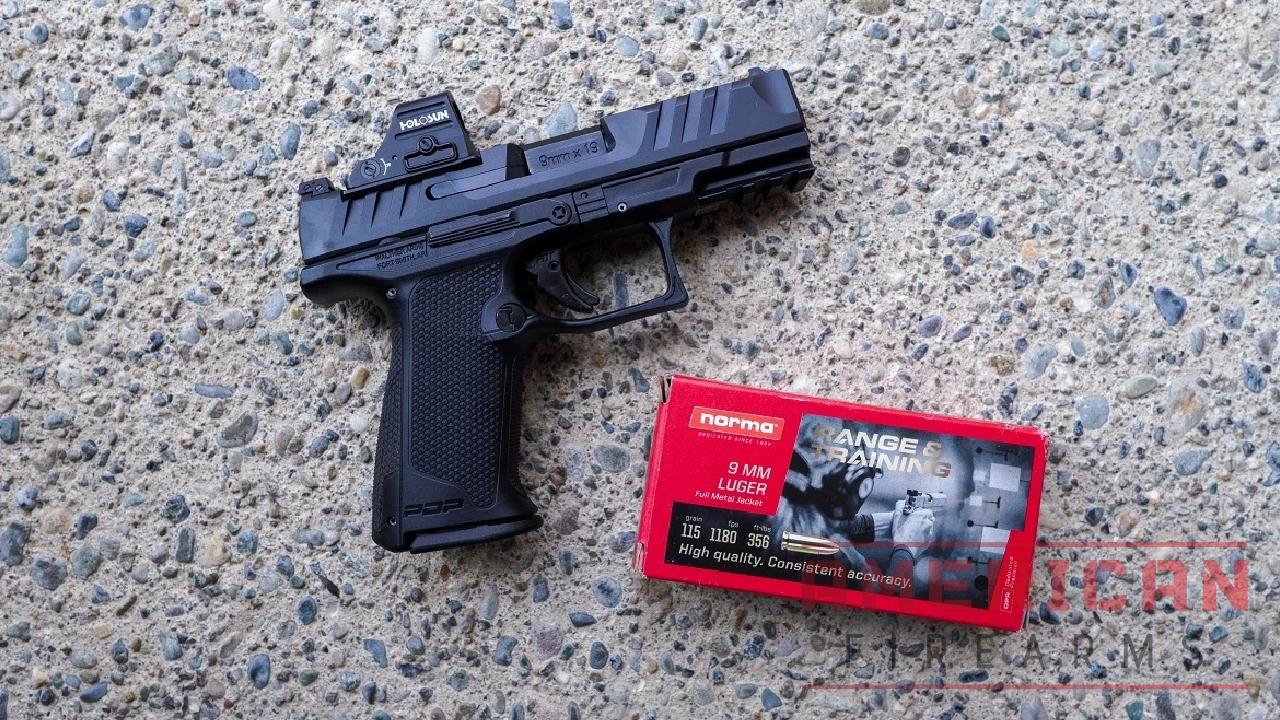
The Walther PDP-F hit the market in 2022 with innovations we haven’t seen before. It was designed for small hands, which usually equates to a tiny pistol, but the PDP-F is anything but. Walther solicited feedback from female shooters and gave us what we’ve been seeking for years.
The PDP-F has a reduced trigger reach which helps small hands get proper trigger finger placement. They also shortened the length of travel and gave it a crisp, clean break. All stages of the trigger are highly tactile and easy to feel.
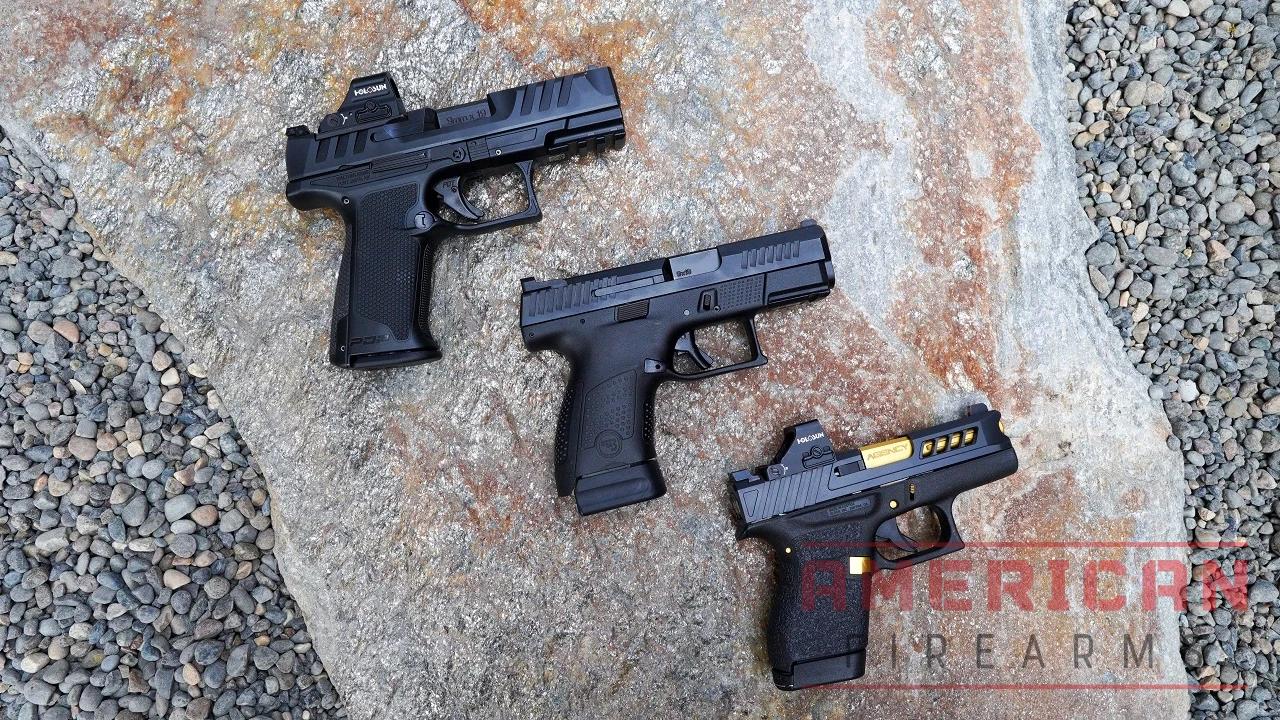
And the recoil is soft on this one, making it easier to get back on target for follow-up shots. It comes red-dot-ready, so if you want to add an optic, it’s easy. Walther also offers a free mounting plate which you can request online depending on the red dot sight you choose. I requested mine and had it within the week, which was nice.
Another area of improvement is the reduced slide force by 20 percent. This change is significant for those with limited grip strength or physical limitations. Even if you don’t have trouble racking a slide, it’s a nice feature that makes handling and manipulating the pistol easier.
The biggest development is the overall ergonomics of the gun. The PDP-F has a reduced grip circumference that feels equally good for small or large hands. They designed it to contour a smaller hand by tightening up the grip in just the right spots.
Having small hands, I’ve found this to eliminate having to readjust my grip between shots.
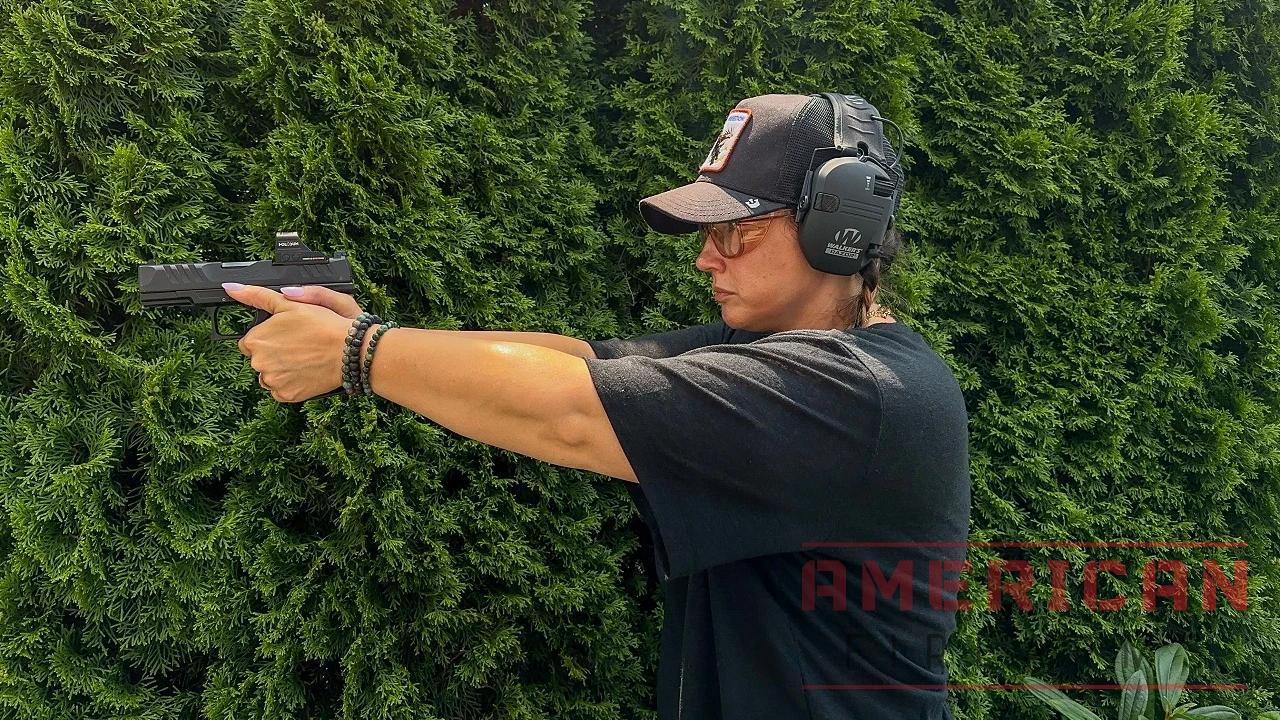
Other great features are SuperTerrain Serrations to help with racking and manipulations and the all-over Performance Duty Texture. It’s a aggressive grip texture, so your hands don’t slip. It’s also non-abrasive, so it won’t tear up your skin or clothes, making it great for concealed carry.
Speaking of concealed carry, the PDP-F is an excellent choice if you can pull it off. It’s slightly too thick for me to conceal easily daily. I did carry it this past winter which was easy in heavier layers. I love how it carries, and I always wish I had a few more inches of torso real estate to hide it.
Beyond being a solid pistol, the Walther PDP-F is simply a beautiful handgun. I picked it for the list as the Best Overall because it has all the qualities you’re looking for.
It’s thoughtfully designed, well-built, and easy on the eyes. If you’ve never experienced a Walther, you’re in for a treat.
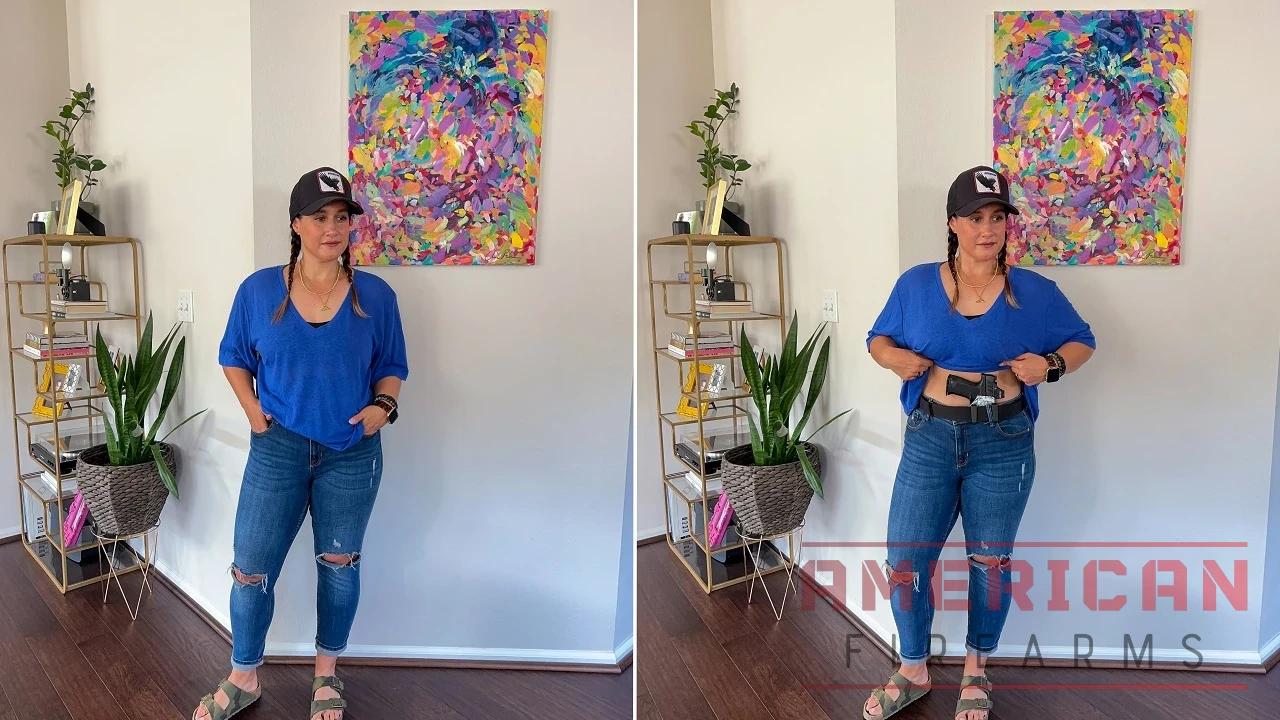
Test Notes:
Ergonomics & Fit: This gun was a revelation for me. As someone with smaller hands, I’ve struggled with pistols that felt too big or required me to shift my grip to reach controls. The PDP-F’s reduced trigger reach let me get proper finger placement without stretching, and surprisingly, my teammates with larger hands loved it too. When I racked the slide, I immediately noticed how much easier it was – Walther’s claim of 20% reduction in slide force isn’t marketing fluff.
Shootability & Accuracy: I was consistently printing 2.5-inch groups at 15 yards from the bench, which is excellent for a carry gun. The trigger breaks cleanly at what felt like a perfect weight – measured at 4.2 pounds – with a reset so short and crisp I could fire follow-up shots faster than I expected. The recoil felt incredibly soft for a 9mm, keeping the gun flat between shots.
Concealability: Here’s where my personal limitations showed up. At 1.34 inches wide, this gun prints on me in anything fitted. I can conceal it under blazers and cardigans, and it disappears under my winter coat, but my summer wardrobe just doesn’t work with it. Larger-framed women on our team had much better luck, which reinforces that body type matters enormously in carry gun selection.
Reliability & Function: I put 200 rounds through it without a single hiccup, mixing everything from budget FMJ to premium hollow points. Magazine drops were positive every time, reloads felt smooth, and the last-round hold-open worked perfectly through dozens of cycles. This gun just runs.
Practical Use Assessment: Field stripping was so simple I could do it in the dark, and those SuperTerrain serrations actually work – no slipping during manipulation. The sights stayed visible even in our low-light testing. If I could conceal this gun easily, it would probably be my daily carry.
2. Best Glock: Glock 43

$420.99

43
EXCEPTIONAL
Performance Scores
The Good:
- Compact and ultra-concealable
- Reliable
- Affordable
- Easy to maintain
- Versatile concealment options
The Bad:
- Single-stack, low capacity
- Mediocre trigger
- Not the best for range shooting
Specs:
- Caliber: 9mm
- Weight: 20.64 ounces
- Barrel Length: 3.41 inches
- Overall Length: 6.26 inches
- Standard Capacity: 6+1

The Glock 43, released in 2015, is a 9mm pistol that’s compact and ultra-concealable. As with other Glock models, it’s well-built, affordable, easy to maintain, and — like all Glocks — an incredibly reliable pistol. And for a carry gun, the fact that it’s dependable is critical.
You won’t find any fancy features on the Glock 43. The ergonomics are good, and if you’re used to shooting Glocks, you’ll be comfortable with this one. The grip texturing is medium which is fine for a carry gun. And all the controls function easily and consistently.
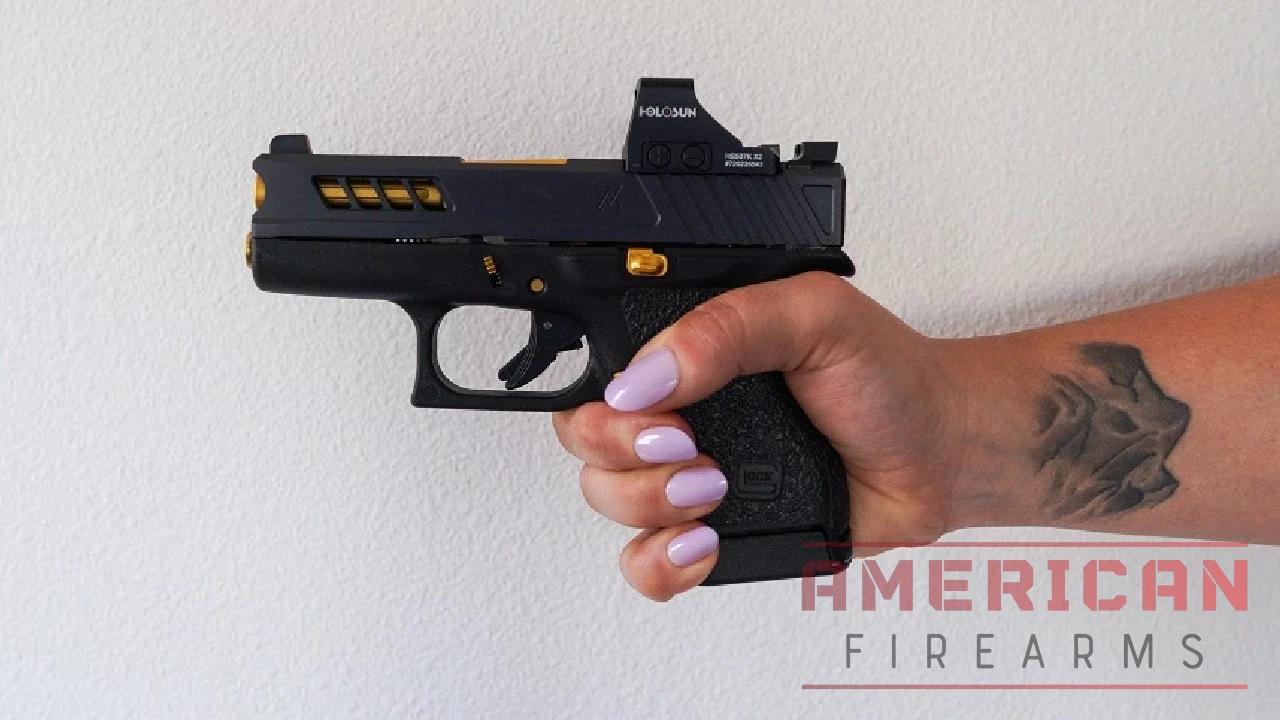
This isn’t a pistol you’ll want to run at the range for hours. It’s got your typical Glock trigger which is not great but also not terrible (although it does have their integrated trigger safety). The Glock 43 has a light, short take-up followed by a wall with a hard break. The biggest issue is that the back half is stiff until you break the gun in. That said, the reset is nice and short.
Even though the Glock 43 isn’t loaded with features, it’s got most of what you want in a carry gun. Plus, the ability to swap or upgrade almost any part. There is an abundance of aftermarket compatible parts for the Glock 43 should you decide to customize it a bit.
I would suggest upgrading to night sights or something that ups the usability when the sun goes down.
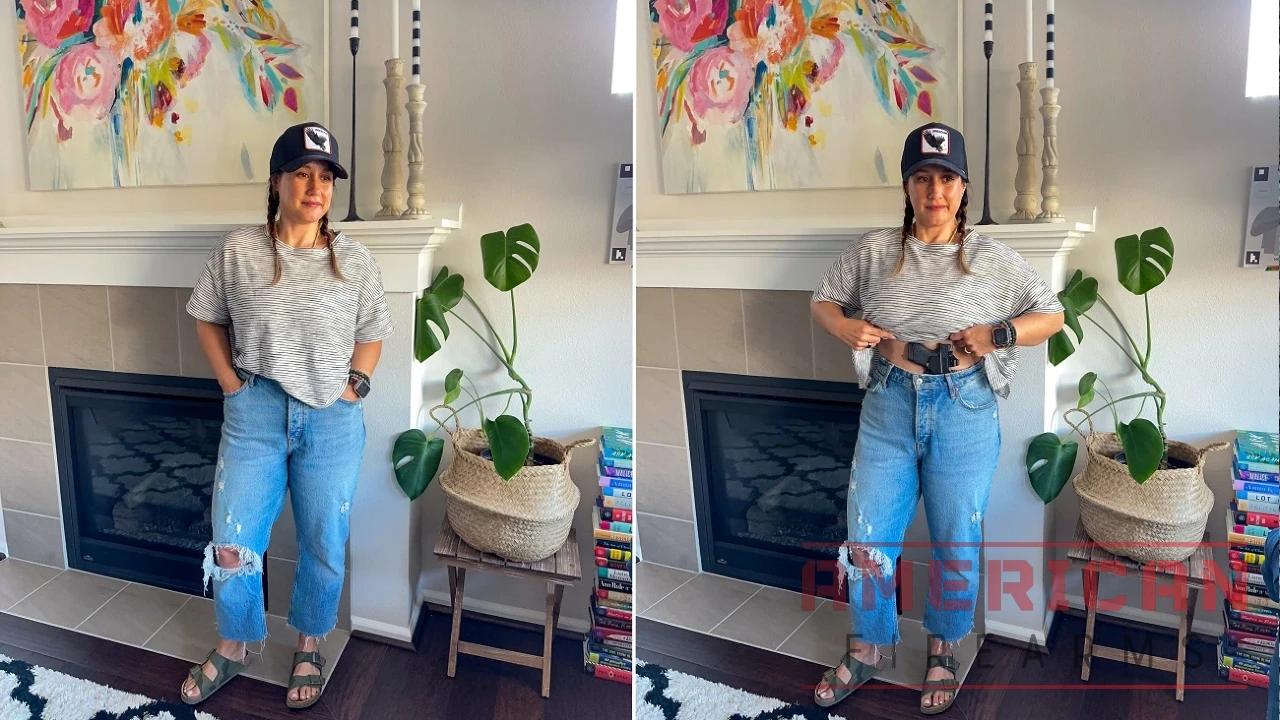
One huge pro of the Glock 43 is that you can conceal it in many positions. Of course, it’s easy to carry appendix inside the waistband, but that’s not all.
I’ve concealed mine in my bra using a Flashbang Holster and, on my thigh, using Dene Adams Thigh Carry Shorts. It can also easily conceal in a wide variety of concealed carry purses and bags.
The biggest drawback of the Glock 43 is that it’s a single-stack, and the standard capacity is only 6+1 rounds. The low round count can make it feel dated when compared to other subcompacts on the market today.
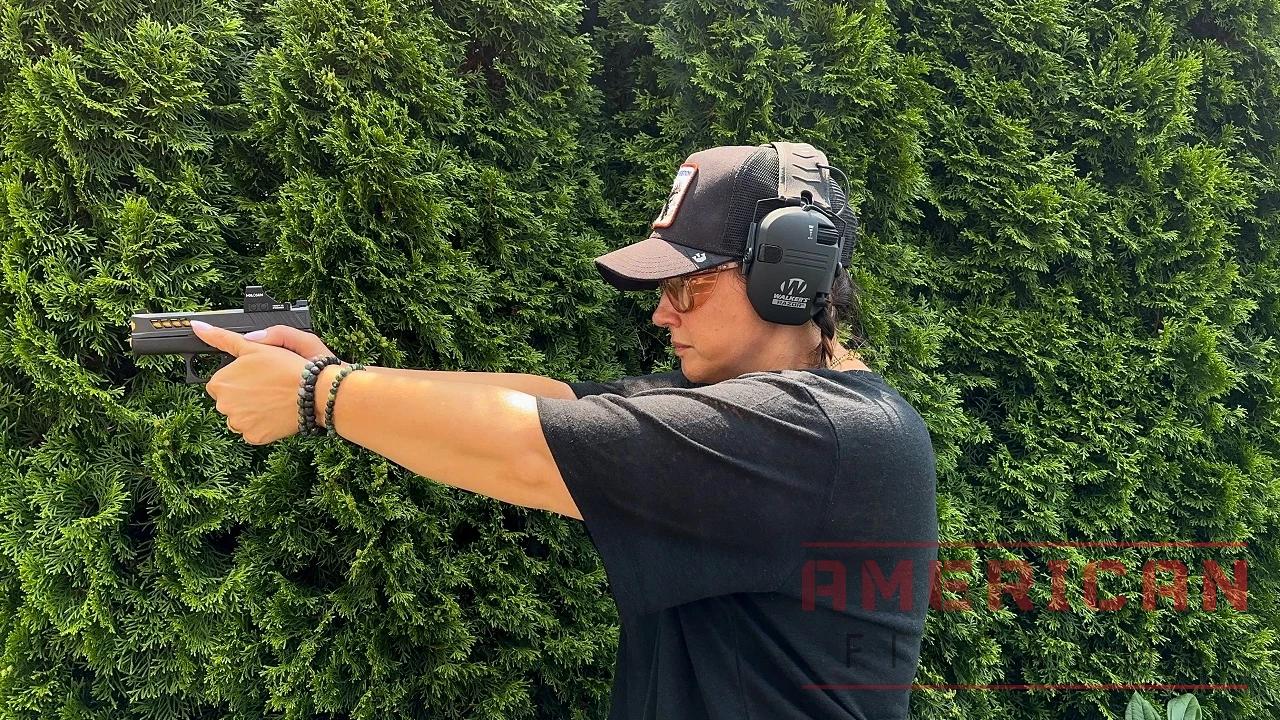
The Glock 43 makes the list as “Best Glock” because of its versatility as a concealed carry gun. As women, we tend to wear a variety of types of outfits, and we’re not always carrying AIWB. It’s nice to have a pistol that can conceal any way you choose.
Check out our hands-on G43 review.
Test Notes:
Ergonomics & Fit: This little gun fits my hands perfectly, though I watched larger-handed teammates struggle with the grip. The slim profile sometimes caused me to lose my grip during rapid fire, but for normal shooting, it felt natural. The slide took more effort to rack than the PDP-F, but nothing I couldn’t handle.
Shootability & Accuracy: I averaged 3.2-inch groups at 15 yards, which is respectable for such a small gun. The trigger felt like every other Glock I’ve shot – not great, not terrible, breaking at 5.8 pounds with that familiar wall and clean break. Follow-up shots were manageable, though I definitely felt more muzzle flip than with heavier guns.
Concealability: This is where the G43 shines for me. At just over an inch wide, it disappears under everything I wear. I’ve carried it appendix, on my hip, in a thigh holster, and even in my bra with a FlashBang holster. It’s the most versatile concealment gun I’ve tested.
Reliability & Function: Perfect reliability through 150 rounds of mixed ammunition. I’ve never had a Glock fail me, and this one maintained that reputation. Everything worked exactly as it should, every single time.
Practical Use Assessment: Standard Glock simplicity – field stripping takes seconds once you know the routine. The plastic sights are adequate but nothing special. Magazine changes felt slower than with larger guns due to the short grip, but that’s the trade-off for concealability.
3. Concealed Carry Pick: Glock 48 MOS
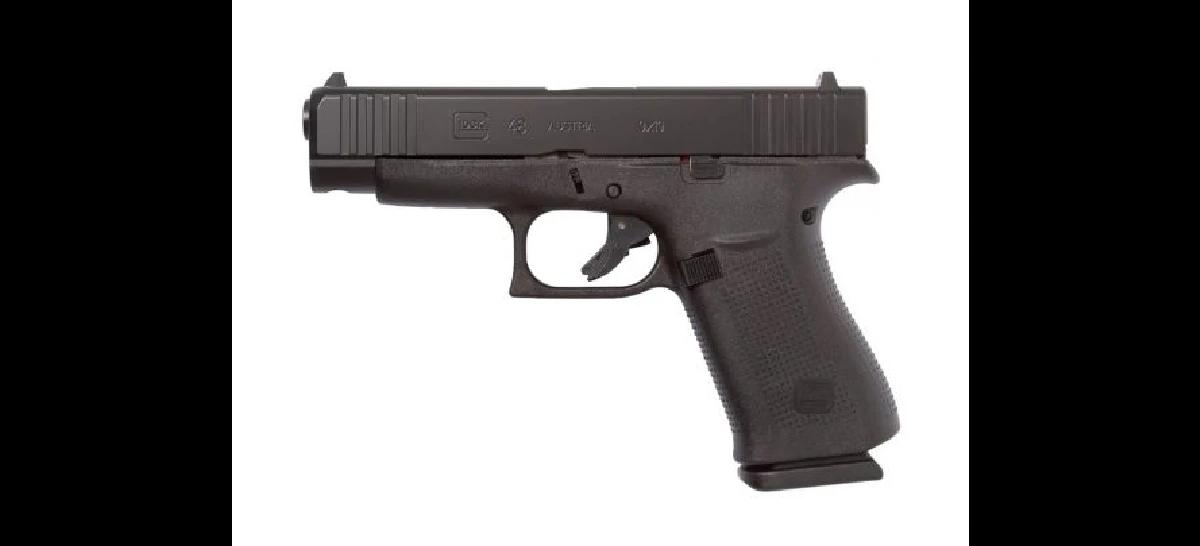
$638.99

42
EXCEPTIONAL
2025 Awards & Rankings
Performance Scores
The Good:
- Reliable and of high-quality
- Slimline design ideal for concealed carry
- No finger grooves to fit various hand sizes
- Moderate texturing to keep hands in place
- Comes optic-ready
- Standard Glock features and trigger
The Bad:
- The grip isn’t particularly ergonomic
- Optic placement may be high for some
- Standard 10+1 capacity may feel limiting
- Issues reported with Shield S15 magazines
Specs:
- Caliber: 9mm
- Weight: 25.12 ounces
- Barrel Length: 4.17 inches
- Overall Length: 7.28 inches
- Standard Capacity: 10+1
The Glock 48 MOS is an optics-ready compact pistol that hit the market in 2019. If you’re familiar with one Glock, you’re familiar with them all, and that’s a good thing. Glocks are uber reliable, and the company has a long record of making quality firearms.
The Glock 48 MOS was designed with concealed carry in mind, and the company refers to it as a “slimline” model. It shoots like a compact and carries like a sub-compact. It’s a skinny Glock 19. For many people, me included, it’s the best of both worlds. I’ve carried mine for four years, only swapping to my Glock 43 when the weather gets warm.
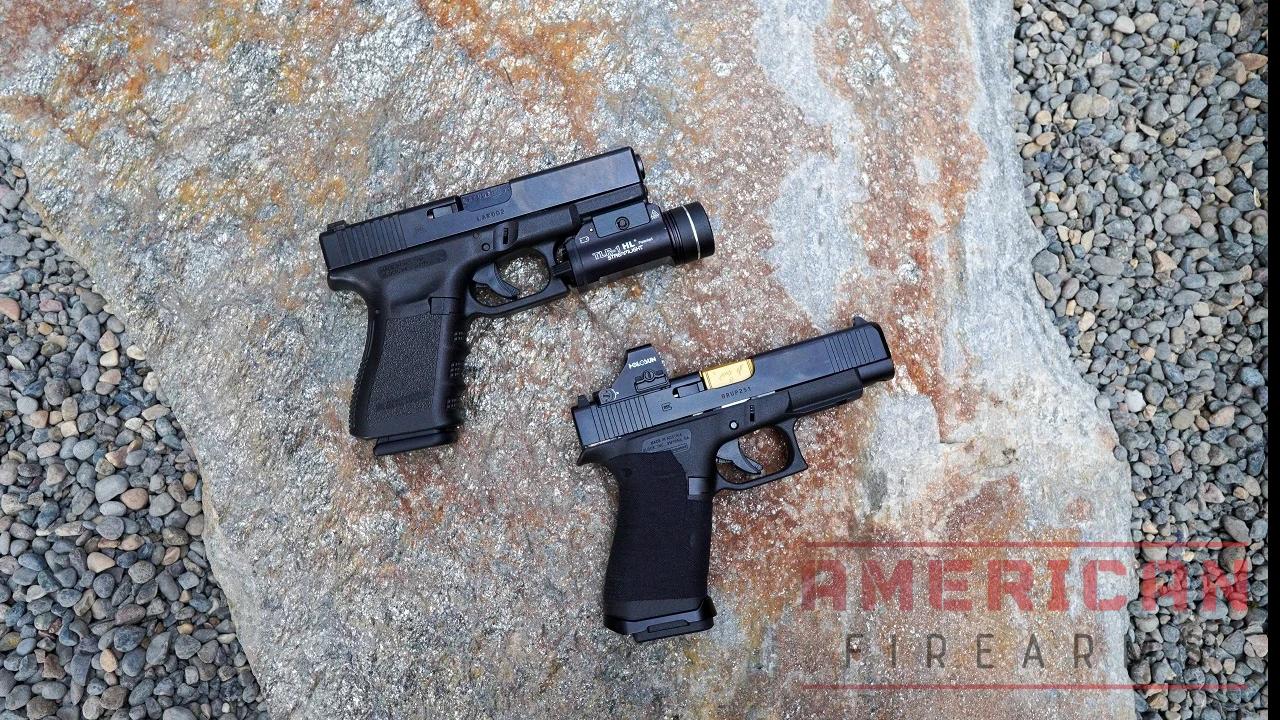
As with other models, the Glock 48 MOS comes with your standard Glock features. The grip isn’t very ergonomic, but it’s not uncomfortable, either. There are no finger grooves on this model, so it fits various hand sizes easily. It’s thin, but it doesn’t impede getting a solid grip.
The texturing is a nice in-between pattern. It doesn’t feel aggressive, but it does work to keep your hands in place. After several magazines, you’ll probably wish it was more aggressive, but while carrying it, you’ll be happy.
The MOS version comes optic-ready, which is a plus. You’ll need an optic adapter plate depending on the red dot sight you choose. That does put the optic up a little higher than some prefer, but I’ve had no issue running a Holosun 507k for the past four years.
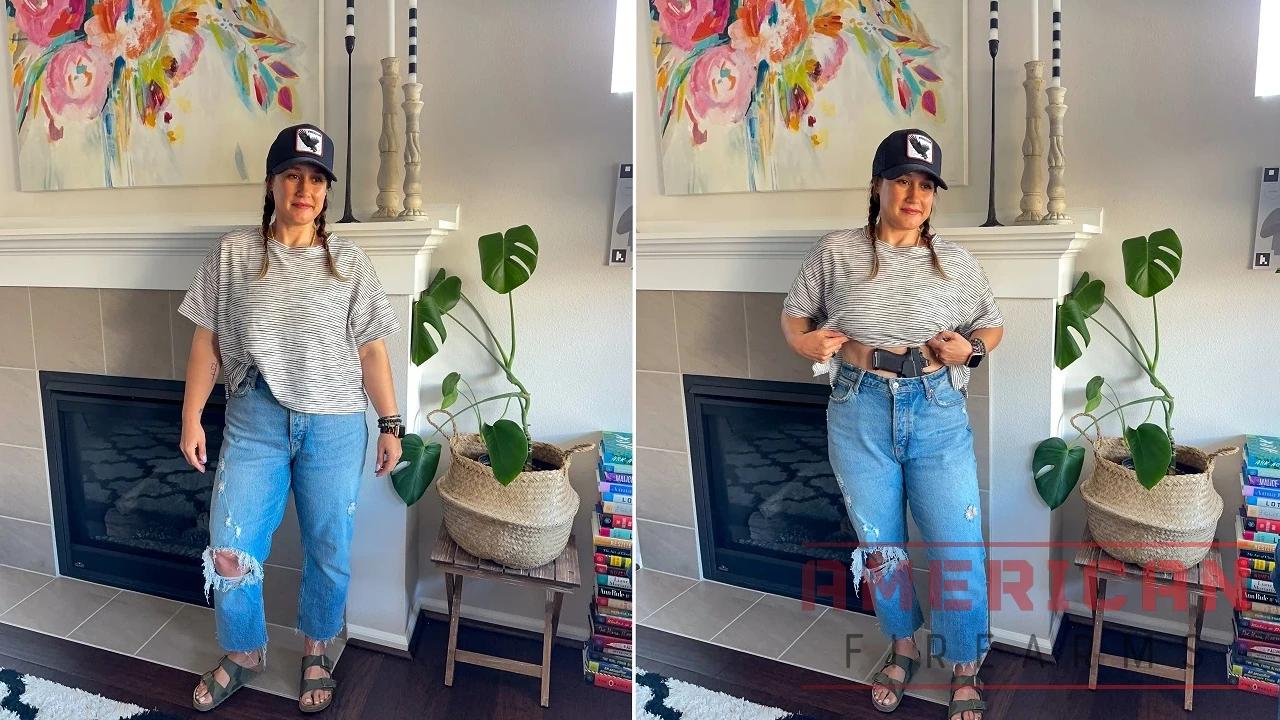
The trigger on the Glock 48 MOS is what you’d expect on any other Glock pistol. It’s not terrible, but it’s not fantastic either. It falls somewhere in the middle. If you’re used to shooting Glocks, you won’t mind it much. And if you’re not, you can swap it for one of the seven trillion aftermarket triggers available.
One downside is the standard 10+1 capacity which feels small for a pistol this size. You can get 15+1 using Shield S15 magazines which is what I carry. These are flush magazines, too, which are great for concealed carry. I realize many people have had issues with these magazines during the first couple of generations, so be aware and always check your gear. I have a few that have hundreds of rounds through them without issue so far.
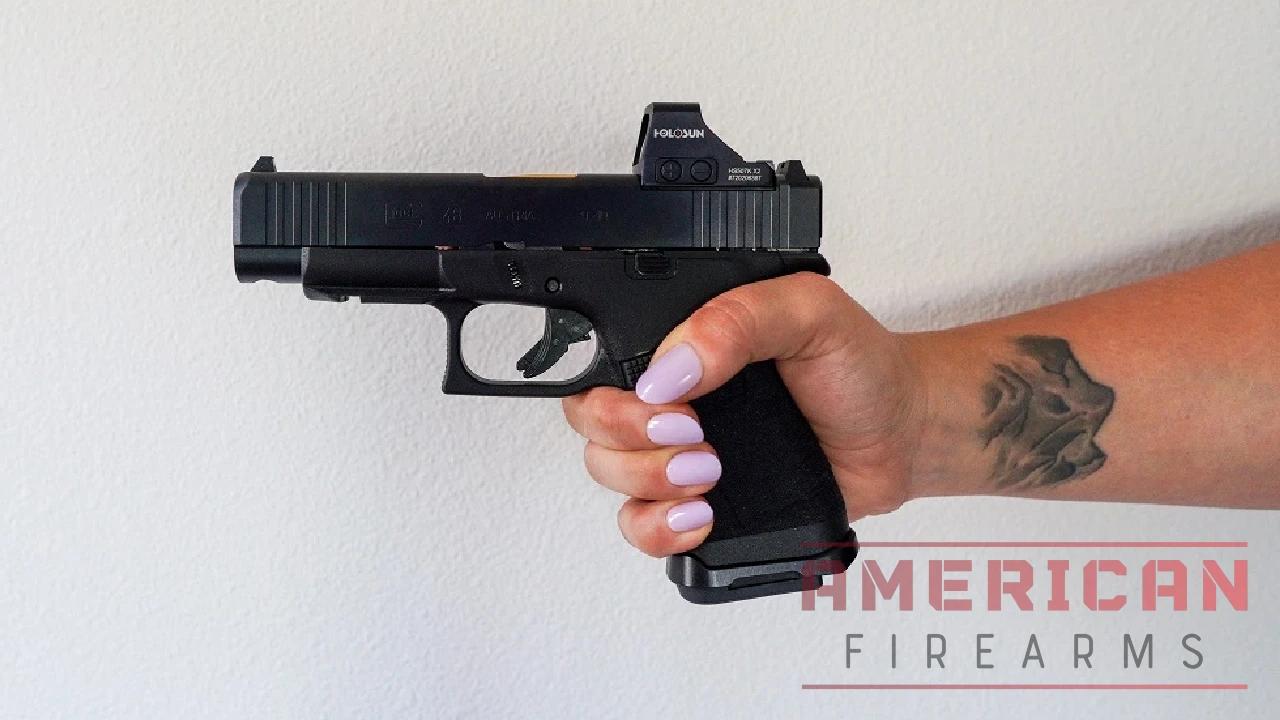
Overall, the Glock 48 MOS is a great pistol. It makes the list as Concealed Carry Pick because of its size and versatility. It’s not too big for concealed carry and not so small that it beats you up at the range. The Glock 48 MOS is just right.
Test Notes:
Ergonomics & Fit: This gun gives me the best of both worlds – the slim profile I need for concealment with a full-length grip I can actually hold onto. The lack of finger grooves means it fits my hands and my teammates’ hands equally well. Slide manipulation felt typical for Glock – functional but not exceptional.
Shootability & Accuracy: I consistently shot 2.8-inch groups, and the longer sight radius definitely helped my precision. The trigger broke at 5.6 pounds with standard Glock characteristics. The extra weight and grip area made recoil much more manageable than the G43, letting me shoot faster and more accurately.
Concealability: This has been my daily carry for four years, and for good reason. The slim profile hides well under most of my clothes, though the longer grip sometimes prints when I’m sitting. I carry it appendix most of the time and barely notice it’s there.
Reliability & Function: I’ve put hundreds of rounds through my personal G48 MOS without issues, and our test gun maintained that standard with zero malfunctions. The MOS system worked perfectly with my Holosun 507k, though you do need adapter plates. I also tested it with Shield Arms 15-round magazines, which worked fine for me, though I know some people have had issues with earlier versions.
Practical Use Assessment: Same simple Glock maintenance I’m used to. The MOS mounting was straightforward once I had the right plate. It’s not the most exciting gun I’ve tested, but it’s reliable, concealable, and shoots well – exactly what I want in a carry gun.
Check out our full hands-on review of the Glock 48.
4. Czech Pick: CZ P10S

$564.99

42
EXCEPTIONAL
2025 Awards & Rankings
Performance Scores
The Good:
- High-quality and reliable.
- Crisp trigger with short reset.
- Ergonomic grip with good recoil control.
- Interchangeable backstraps and effective pebbled texture.
- Standard magazine capacity of 12+1
The Bad:
- Can feel off-balance and tippy when carried in a sub-compact-sized holster
Specs:
- Caliber: 9mm
- Weight: 24.4 ounces
- Barrel Length: 3.5 inches
- Overall Length: 6.6 inches
- Standard Capacity: 12+1
The CZ P-10 S is a sub-compact variant of CZ’s popular P10 lineup. The CZ P-10 C (compact) was released first, followed by the P-10 F (full size), and then came the P-10 S (subcompact). ‘
As with all CZ handguns, the P-10 S is a high-quality, reliable handgun and even comes with some improvements over the P-10 C.
The most significant upgrade is the trigger which feels much crisper than the original variation. The trigger pull is only 4 pounds and 10 ounces, and it breaks clean. The reset is very short and quick. I’ve shot a lot of different striker-fired pistols, and the P10S trigger is one of the best.

One of the best features of the P10S is the grip. It’s extremely ergonomic, and it just feels good in the hands. The grip angle is better than many similar-sized pistols and allows for good recoil control.
Although it’s a subcompact size, the P10S doesn’t suffer from the fit challenges that a number of subcompact handguns can fall prey to — it’s equally comfortable for small and large hands. It comes with interchangeable backstraps to help customize the grip. And it has a nice, pebbled texture which isn’t overly aggressive but works well.
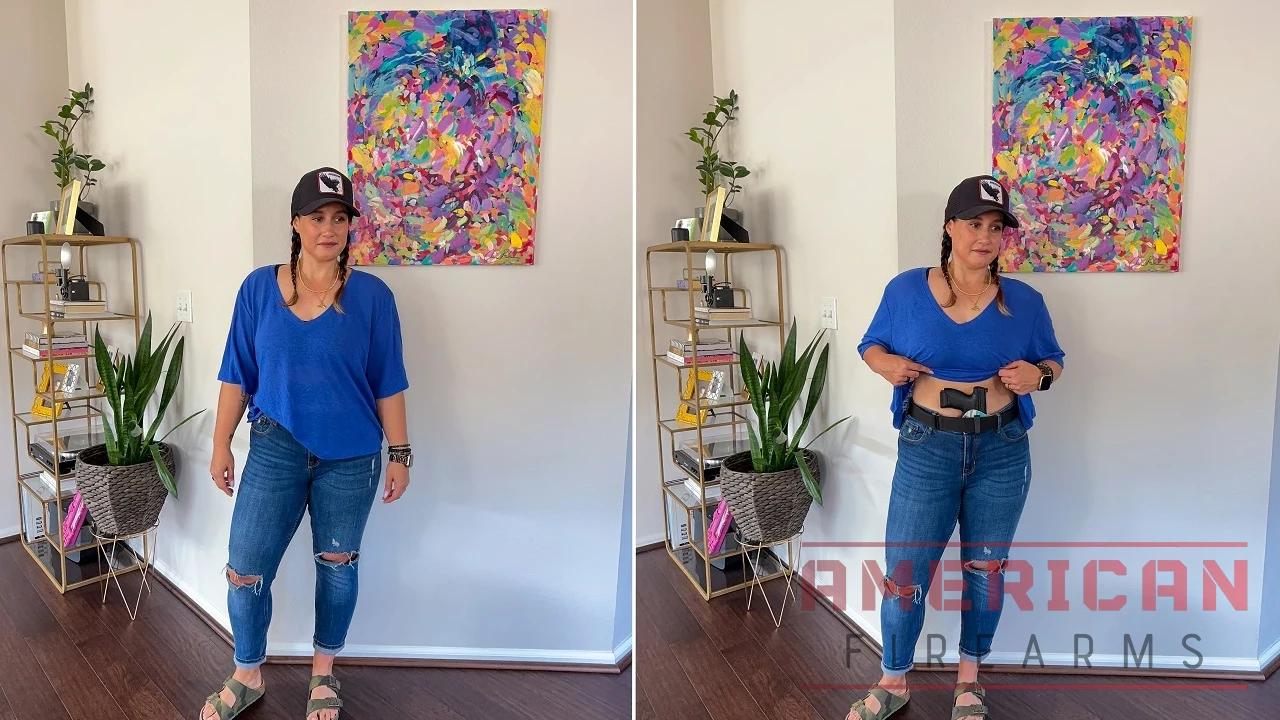
The CZ P-10 S has a standard magazine capacity of 12+1, making it a good option for concealed carry. I would suggest carrying it in a P-10 C holster to get the extra muzzle length.
Otherwise, it feels a bit off-balance and tippy at the belt line.
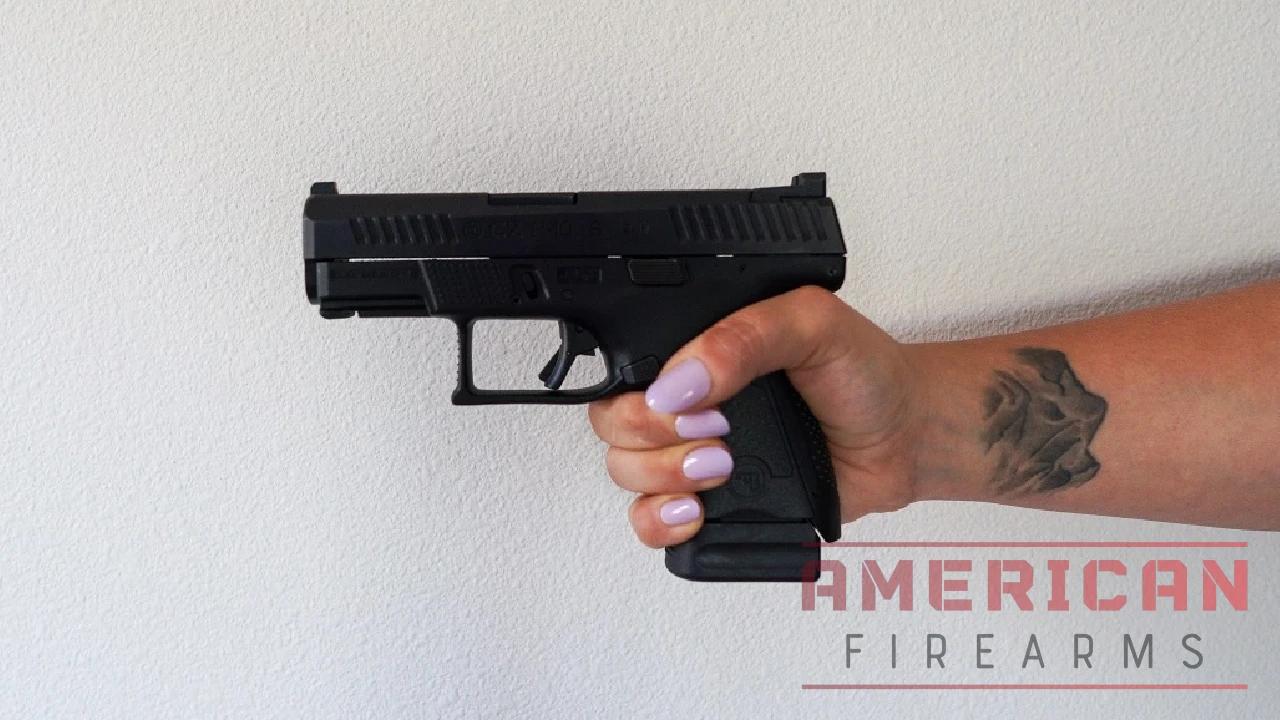
Overall, the P-10 S is exactly what you’d expect from CZ. It’s well-built, good-looking, and very fun to shoot. As someone who carries daily, I also appreciate the size and capacity.
The P-10 S made this list because as far as this polymer-framed striker-fired pistol goes, it “Czechs” all the boxes. Read more on the P-10 S? Check out our full review.
Ergonomics & Fit: The grip angle on this gun is absolutely perfect – better than any striker-fired pistol I’ve tested. It points naturally for me, and the interchangeable backstraps let me dial in the perfect fit. The grip texture gave me great purchase without tearing up my hands during extended shooting.
Test Notes:
Shootability & Accuracy: This gun has the best trigger I’ve experienced on a striker-fired pistol. It breaks cleanly at 4.7 pounds with a reset so short and positive it surprised me. I shot my tightest groups of the entire test session – 2.3 inches at 15 yards – and follow-up shots were incredibly fast.
Concealability: At 1.26 inches wide, it’s thicker than single-stack guns but still conceals well for me. I did notice it felt “tippy” in some of my shorter holsters designed for subcompacts, so I’d recommend using a holster made for the compact P-10 C to get better balance.
Reliability & Function: I had one minor hiccup with light 115-grain loads – a case didn’t fully eject – but switching to 124-grain ammunition solved the problem completely. The 12+1 capacity in such a compact package impressed everyone on our team.
Practical Use Assessment: Field stripping was intuitive, and the build quality feels premium in a way that justifies the price. Everything about this gun screams quality, from the finish to the way the controls operate. If CZ had better aftermarket support, this might be my top recommendation.
5. Easiest to Rack: SW Shield EZ
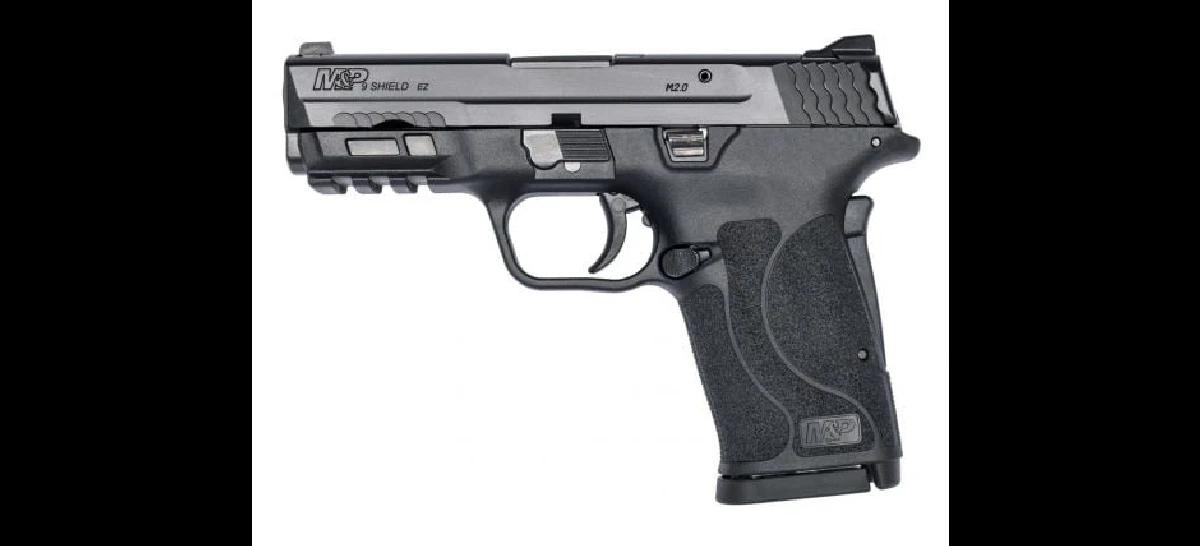
$425.99

31
AVERAGE
2025 Awards & Rankings
Performance Scores
The Good:
- Easy-to-rack slide
- User-friendly magazine
- Angled grip that aids shooting
- Includes grip safety and optional manual safety
- Light and clean trigger pull
The Bad:
- Sluggish trigger reset
- 8+1 capacity
The Smith and Wesson Shield EZ a 9mm semi-automatic handgun that’s designed to be easier to use than most others. It’s a great size for a self defense handgun, which makes it a solid option for those who struggle to operate other concealed carry guns.
The most unique feature of the Shield EZ is its easy-to-rack slide. SW designed it to require less force to operate compared to other similarly sized pistols. The spring is much softer than normal, making it incredibly smooth and easy to rack.
The standard single-stack 8+1 capacity magazine is also designed for ease of use. Most magazines take some force to load to full capacity, but not the Shield EZ. The pull tabs on either side of the magazine make loading a breeze.
The grip is angled to make shooting easier on the hands and wrists. The 18-degree angle lends to most shooters’ natural point of aim. It comes with a nice in-between texture in all the right spots and good palm swell.
One of the safety features is the large grip safety on the backstrap. This prevents the trigger from engaging unless the safety is fully depressed. In addition, you can buy the Shield EZ with or without a manual safety lever.
The trigger breaks at around 4.5 pounds and is clean. However, the reset is somewhat less crisp than other similar pistols. But still, it’s a very easy-to-operate trigger.
Overall, the Shield EZ is another nice pistol from Smith and Wesson. It makes the list because it’s easy to rack, shoot, and handle. It’s important to have well-built options for shooters who struggle with strength, dexterity, disabilities, or aging.
Test Notes:
Ergonomics & Fit: The headline feature worked exactly as advertised – I could rack this slide with minimal effort, making it perfect for anyone with hand strength limitations. The grip angle felt natural and helped with my point of aim. The texture was comfortable for extended shooting without being too aggressive.
Shootability & Accuracy: I shot 3.8-inch groups, which was adequate but not exceptional. The trigger broke cleanly at 4.5 pounds, but the reset was noticeably sluggish compared to other guns in our test. Still, the mild recoil made it pleasant to shoot for long sessions.
Concealability: The single-stack design concealed well on me, and the grip safety didn’t add meaningful bulk. I carried it in several different positions and holster types without issues.
Reliability & Function: I had one feeding issue with truncated cone hollow points, but ball ammunition ran perfectly. The easy-loading magazines really do work as claimed – I could load them to full capacity without the thumb pain I usually experience.
Practical Use Assessment: I appreciated that field stripping didn’t require pulling the trigger – a nice safety touch. This gun clearly prioritizes ease of use over ultimate performance, which makes it perfect for its intended audience but might frustrate more experienced shooters looking for faster handling.
6. Competition Pick: Canik SFx Rival
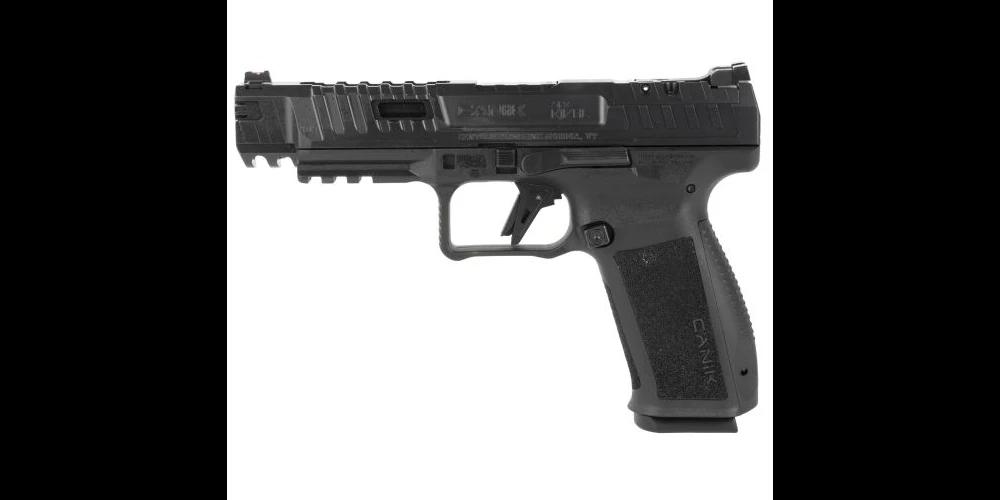
$630.99

55
EXCEPTIONAL
2025 Awards & Rankings
Performance Scores
The Good:
- Ready-to-use for competitive shooting.
- Smooth trigger with quick reset.
- Mild recoil.
- Comes with numerous accessories.
- Good for both competitive shooting and home defense.
The Bad:
- Heavier than other handguns.
- Limited aftermarket support.
Specs:
- Caliber: 9mm
- Weight: 29.5 ounces
- Barrel Length: 55 inches
- Overall Length: 8.1 inches
- Standard Capacity: 18+1
Canik is a brand you may not be familiar with, but they’re worth looking into. They produce high-quality firearms in Turkey, and Century Arms imports them into the United States. The Canik SFx Rival, a competition gun, is one of their latest offerings.
The Canik SFx Rival is full of cool features. If you’re just starting in competitive shooting, you can run it right out of the box. Most competitors like to customize their guns, but the SFx Rival might be one you leave stock. National and World Champion shooter Nils Jonasson worked with Canik on the design to give shooters a fast shooting pistol with lighter recoil.
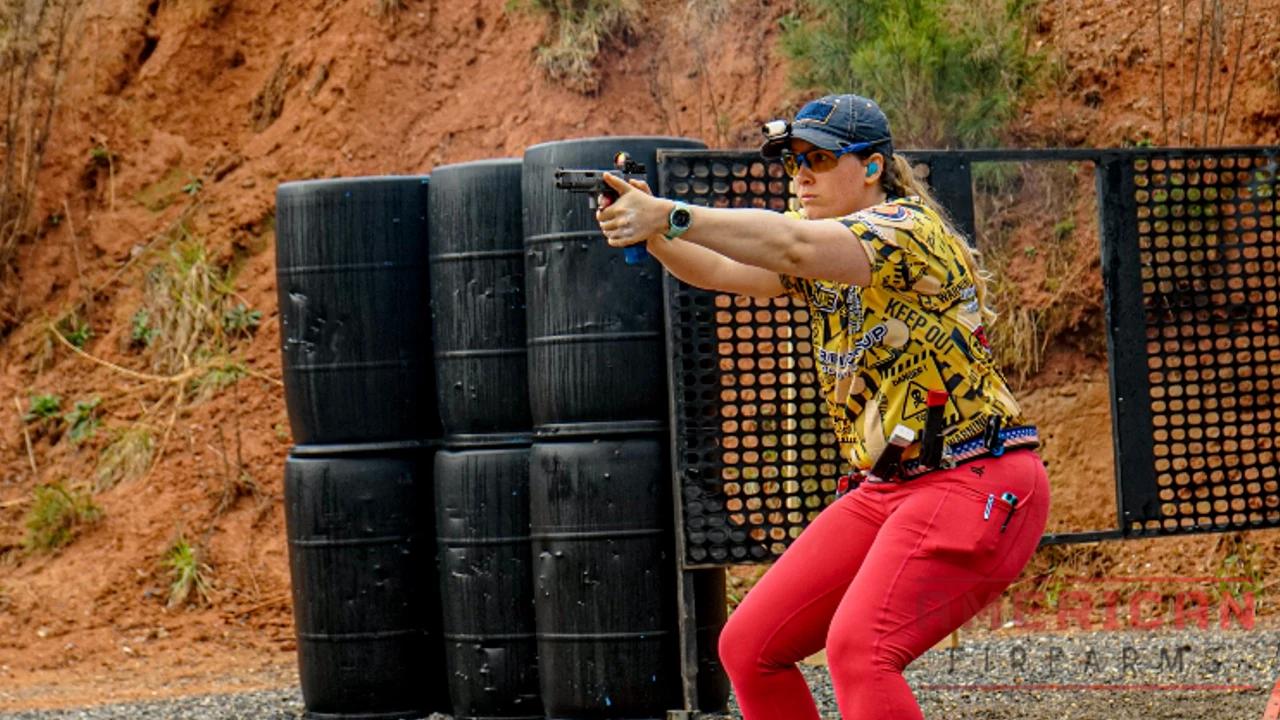
The SFx Rival comes with a diamond-cut aluminum flat-faced trigger that’s a joy to shoot. If you’re used to shooting subcompacts, you’re in for a treat with this type of pistol. Everything about the trigger pull is smooth. It also has a very quick reset, allowing you to shoot fast with really mild recoil. It’s a touch heavier than other handguns, but that’s why it’s a competition pick, rather than something you’d want to carry.
This pistol also comes with many accessories like two magazines and two base plates, a cleaning kit, a punch and tool kit, optical plates, and more. You can’t beat the whole package for the price. Competitive shooting is an expensive sport with lots to buy. Getting everything in one purchase is a big plus, especially for new competitive shooters.
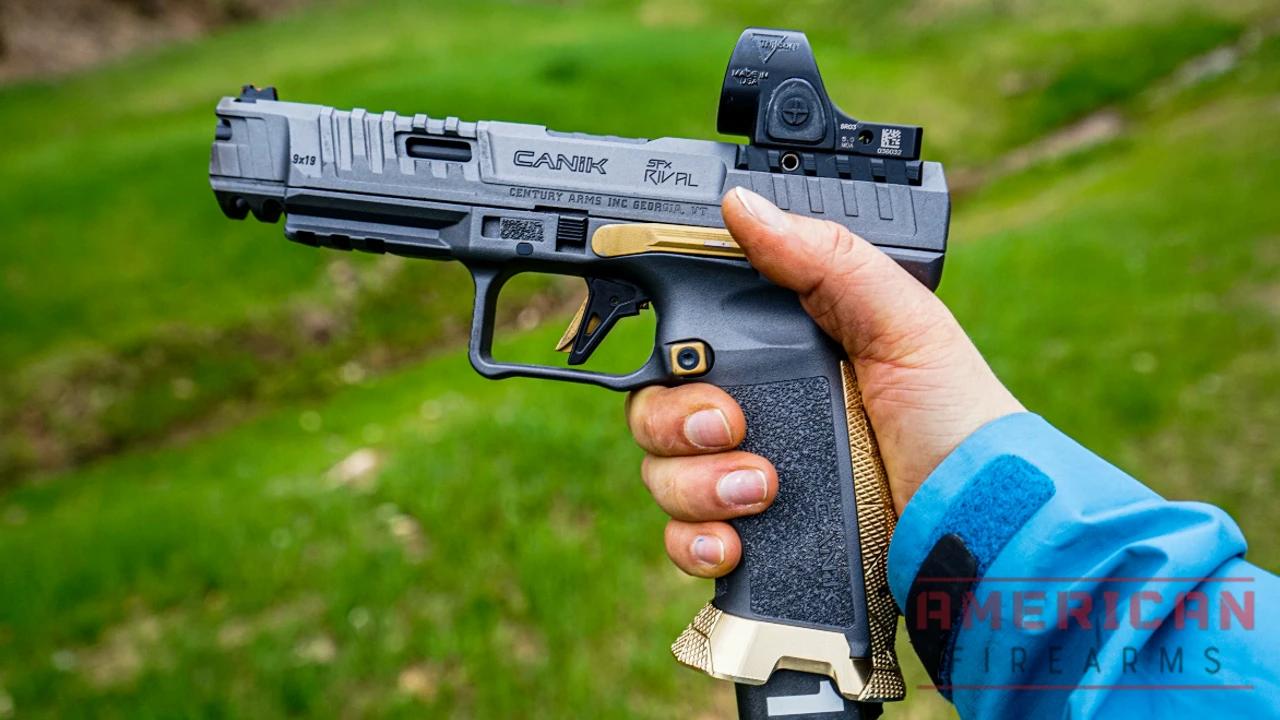
The biggest con to Canik guns is that there is little aftermarket support compared to other manufacturers. It’s good that it comes with much of what you need because aftermarket stuff is hard to find. You’ll be limited in choosing parts and accessories like holsters.
The Canik SFx Rival comes in as the Competition Pick because you can take it out of the box and shoot a match on the same day. That’s rare for competition guns, so it’s nice that Canik listened to shooter’s feedback and delivered. And if competition isn’t your thing, this would be a solid choice for a home defense pistol.
Test Notes:
Ergonomics & Fit: This gun fits my hands beautifully, with an excellent grip angle and texture that gave me total control. The weight is noticeable – 29.5 ounces loaded – but that mass contributes directly to the exceptional shooting characteristics.
Shootability & Accuracy: This was the most accurate gun in our entire test, delivering 1.8-inch groups that made me look like a better shooter than I am. The flat aluminum trigger breaks at a crisp 3.8 pounds with the shortest reset I’ve ever experienced. Rapid fire was effortless – the gun barely moved between shots.
Concealability: Let’s be honest – this isn’t a carry gun. At 8.1 inches long and nearly two pounds loaded, concealing it would require a complete wardrobe change and serious commitment. It’s designed for competition and home defense, not daily carry.
Reliability & Function: I put over 300 rounds through it without a single malfunction, testing everything from light 115-grain plinking ammo to heavy 147-grain loads. Magazine changes were lightning-fast, and every control worked smoothly throughout extended shooting sessions.
Practical Use Assessment: Field stripping was straightforward, and the included accessories – extra magazines, cleaning kit, optic plates – added serious value to the package. The build quality exceeded my expectations, especially at this price point. If you’re getting into competition shooting, this gun is ready to run right out of the box.
If you want more check out our full hands-on SFx Rival review.
Concealed Carry and Holster Guide
Let me be brutally honest: finding the right way to carry concealed as a woman can be more challenging than picking the gun itself. I’ve spent more money on holsters that didn’t work than I care to admit, and I’ve got a drawer full of “solutions” that were anything but. The good news? Once you figure out what works for your body and lifestyle, carrying becomes second nature.
The reality is that women’s bodies and clothing are different from men’s, and the concealed carry industry has been slow to catch up. But things are changing, thanks in part to pioneers like Lisa Looper, founder of Flash Bang Holsters, who recognized that women needed carry options designed specifically for us, not just smaller versions of men’s gear.
Understanding Your Body and Wardrobe
The first step in successful concealed carry is taking an honest inventory of how you dress. I learned this lesson during my first summer of carrying when I realized my favorite fitted sundresses weren’t exactly holster-friendly. Women need to be more creative with concealment because our clothing tends to be more form-fitting.
Your body shape matters too, and I don’t mean that in a judgmental way – I mean it practically. Where you carry comfortably depends on your torso length, hip width, and even your bust size. What works perfectly for your tall, athletic friend might be completely wrong for you, and that’s okay.
On-Body Carry Options
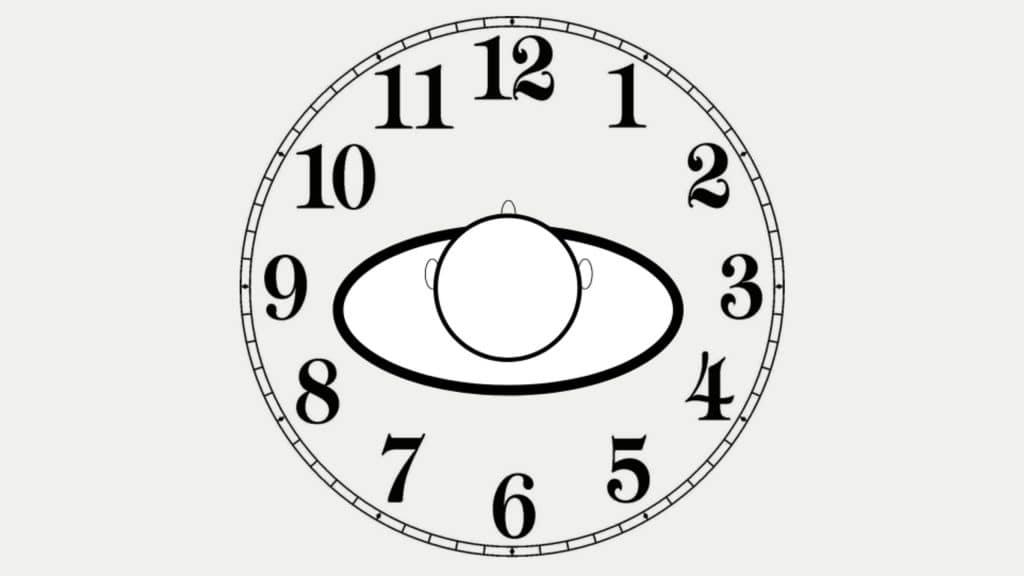
Appendix Inside the Waistband (AIWB) This is my go-to position for most of the year. The gun sits at the front of your body, typically between 12 and 2 o’clock. It offers excellent concealment under most tops and provides a fast, natural draw stroke. The downside? It can be uncomfortable when sitting, especially in cars, and some women find it prints more when wearing fitted shirts.
I carry my Glock 48 MOS appendix daily, and after the initial adjustment period, it became completely natural. The key is finding a holster with the right cant (angle) and ride height for your body.
Strong-Side Hip (3-4 o’clock) This traditional carry position works well under jackets, cardigans, or loose-fitting tops. It’s comfortable for most people and feels natural if you’re used to wearing things on your hip. The challenge for women is that this position can print easily under fitted clothing, and depending on your hip shape, the gun can stick out or dig in uncomfortably.
Small of Back I’ll be direct: I don’t recommend this position. While it can conceal well under certain clothing, it’s slower to access, and there’s a real risk of spinal injury if you fall backward. Professional trainers like Massad Ayoob have been warning against small-of-back carry for decades, and I think their concerns are valid.
Ankle Carry This works well for backup guns or if you frequently wear pants and boots. It’s completely concealed, but the draw is slow and awkward. I know several female law enforcement officers who use ankle holsters for off-duty backup guns, but it’s not practical as a primary carry method for most of us.
Off-Body Options (When On-Body Won’t Work)
Let’s acknowledge reality: sometimes on-body carry just isn’t practical. Maybe you’re wearing a bridesmaid dress, or you have a formal work environment, or you’re dealing with medical issues that make belt carry uncomfortable. That’s where off-body options come in.
Concealed Carry Purses I was skeptical of gun purses for years, thinking they were just a marketing gimmick. Then I tried a well-designed one from Gun Tote’n Mamas, and my opinion changed completely. A good concealed carry purse has a dedicated, holstered compartment that keeps the gun secure and properly oriented.
The key rules for purse carry: the gun must be in its own compartment with nothing else, the purse must never leave your body, and you need to practice drawing from it regularly. I use mine primarily for situations where I can’t carry on-body, and it’s been a game-changer for formal events.
Thigh Holsters These have become increasingly popular, especially for women who wear dresses or skirts regularly. The FlashBang holster attaches to your bra and positions the gun on your upper torso, while thigh holsters like the ones from Can Can Concealment sit on your leg under skirts or dresses.
I’ve tried both, and they work, but they require practice and the right clothing. The thigh holster was surprisingly comfortable, but the draw stroke took some getting used to.
Holster Quality and Features
Here’s where I’ll channel my inner gun safety instructor: never, ever compromise on holster quality. A good holster does four critical things: covers the trigger guard completely, holds the gun securely, allows for a consistent draw, and enables safe reholstering.
I learned this lesson expensively when a cheap holster’s retention failed, and my gun nearly fell out while I was walking through a grocery store. That was the last time I bought a holster based on price alone.
Look for holsters made from quality Kydex or leather by reputable manufacturers like Vedder, Alien Gear, or JM Custom Kydex. Yes, they cost more than the generic options, but your safety is worth the investment.
Adjustable retention is crucial – you want the gun secure enough that it won’t fall out during normal activity, but not so tight that you can’t draw it smoothly under stress.
Proper cant and ride height make all the difference in comfort and concealability. Most quality holsters offer adjustable cant, letting you find the angle that works best for your body and clothing.
Dressing Around Your Gun
This might be the most important skill that no one talks about. Carrying concealed often means making small adjustments to your wardrobe. I’ve gradually shifted toward slightly looser-fitting tops, and I’ve discovered that patterns and textures hide printing better than solid colors.
Layering becomes your friend. A light cardigan or unbuttoned shirt can hide a lot of sins, and they’re appropriate in most social and professional settings. I keep a lightweight blazer in my car specifically for situations where I need extra concealment coverage.
Belt choice matters more than you might think. A good gun belt distributes the weight evenly and prevents sagging or shifting. Companies like Hanks Belts and The Belt Man make excellent options that look like normal dress belts but provide the support you need for carry.
Practice and Consistency
Kathy Jackson, founder of The Cornered Cat website and a respected firearms instructor, emphasizes that carry method consistency is crucial for developing muscle memory. Switching between different carry positions or holsters regularly can slow your draw and create confusion under stress.
Once you find a system that works, stick with it long enough to become proficient. Practice your draw stroke regularly with an unloaded gun, and consider taking a concealed carry class that focuses on drawing from concealment.
The Reality Check
Concealed carry isn’t always comfortable, and it’s never convenient. There will be days when the gun digs into your side, when you can’t wear your favorite outfit, or when you have to plan your activities around your carry setup. That’s normal, and every experienced carrier deals with it.
The goal isn’t perfection – it’s finding a system that works well enough that you’ll actually carry consistently. A smaller gun that you carry every day is infinitely more useful than a larger gun that stays home because it’s too difficult to conceal.
Remember, this is a journey, not a destination. Your carry needs will evolve as your comfort level increases and your lifestyle changes. What matters most is starting with a safe, quality setup and building your skills from there. The investment in time, money, and effort is worth it for the peace of mind that comes with being prepared to protect yourself and those you love.
Tips on Choosing a Handgun
Choosing a handgun can feel intimidating, but it doesn’t need to be. If you follow a few guidelines, you can find the right one.
Handle (Or Even Better, Shoot) Before Buying
First, only purchase a gun after handling it yourself. You need to go to the store and hold it to see how it feels in your hands. Manipulations like racking the slide, pulling the trigger, and dropping the magazine can vary widely between guns. It’s best to do and feel those yourself before you commit.
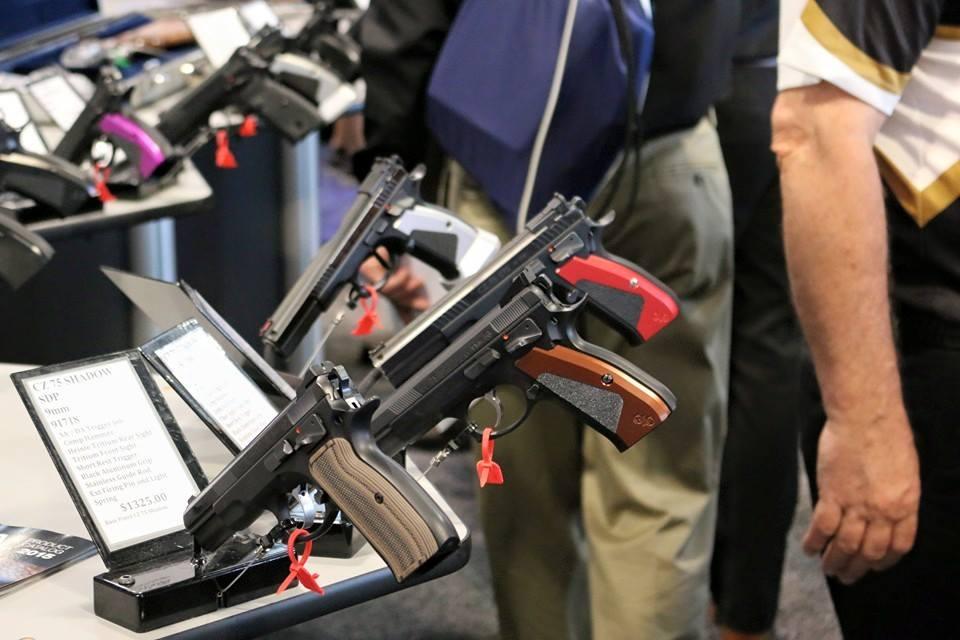
I’ll take it a step further and add that you should never buy a handgun without shooting it first, too. Guns are expensive, and you can’t return them like your latest Amazon purchase, so you want to be sure. Trying it first will help you see how the gun shoots in real life, figure out if you like shooting it, if you’re accurate with it, if you can handle recoil, and if you can work all the controls easily.
Test a few revolvers, which are simple to use and are often recommended for women, to see if the weight, heavy double-single action trigger pull, and limited capacity are things that would steer you in another direction.
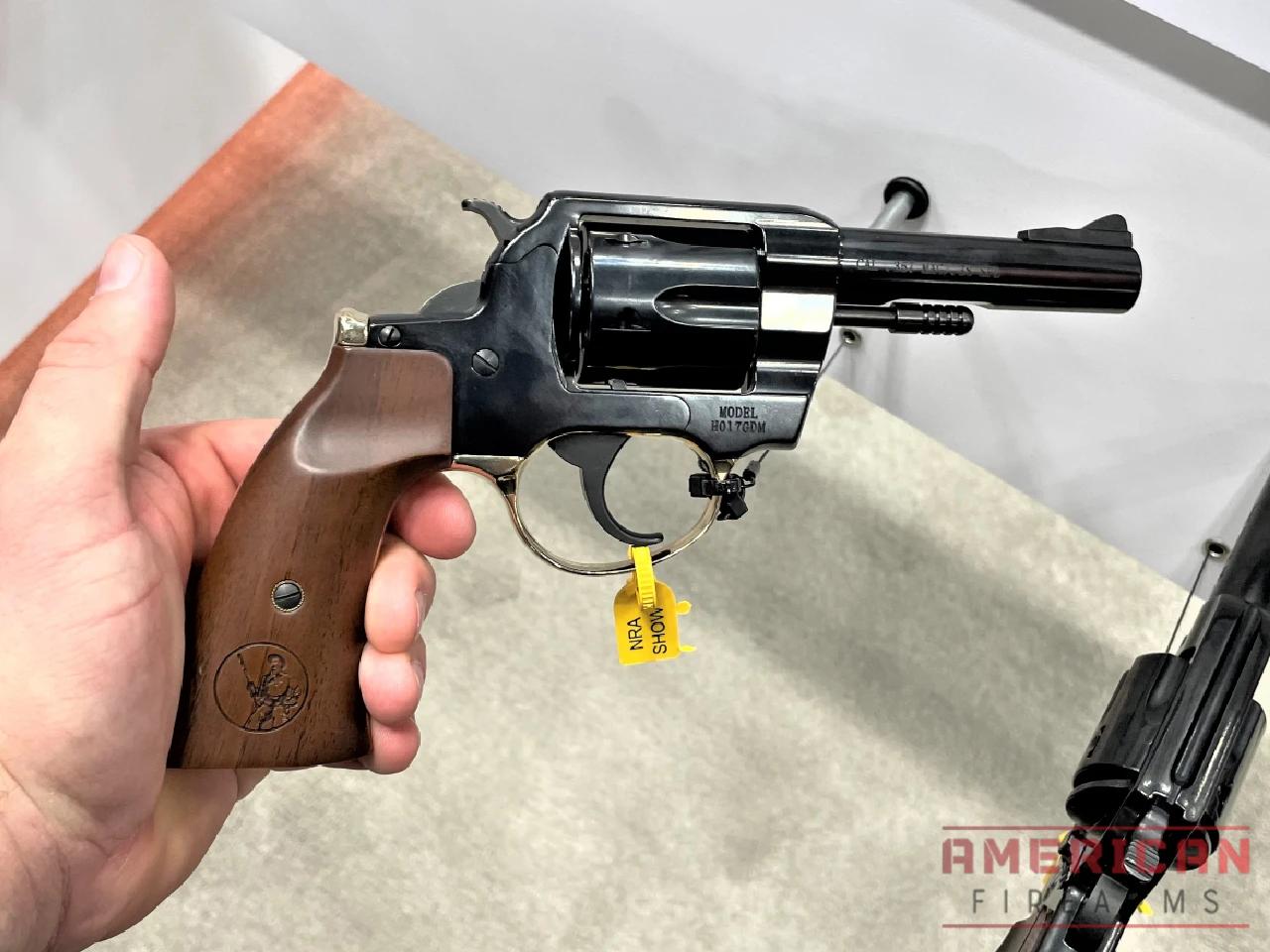
Most ranges rent out a variety of pistols for a minimal fee. If you’re shopping around, make a list of the top 3-5 guns you’re looking at and rent them. Now narrow it down to just a couple and consider renting them a second time to see how you feel.
Stick with 9MM
When considering pistols for concealed carry use, stick with models chambered in 9mm, for a few reasons. First, these pistols generally have higher magazine capacities compared to larger calibers, so you can carry more rounds without an equivalent increase in size.
Secondly, full-size and compact 9mm handguns keep recoil manageable, especially when compared to a .45 ACP, 10MM, or .40SW chambered pistol. This translates into faster follow-up shots and better accuracy, critical in high-stress situations.
Lastly, 9MM is relatively widespread, available, and cheap making it a practical choice for regular training sessions. Plus, if you’re planning on carrying a 9mm pistol, it makes sense to start there.
Avoid The Small Pistols
And finally, don’t assume that the smallest handgun is the best just because you’re a woman. Small guns stink to shoot. That would-be pocket pistol is going to have snappy recoil that makes it hard to hold onto, especially if you’re a new, inexperienced shooter.
Too much recoil will likely cause you to put even the most popular handgun away in your safe rather than actually practice with it. A bigger, heavier pistol has more mass, which translates into less recoil for the shooter.
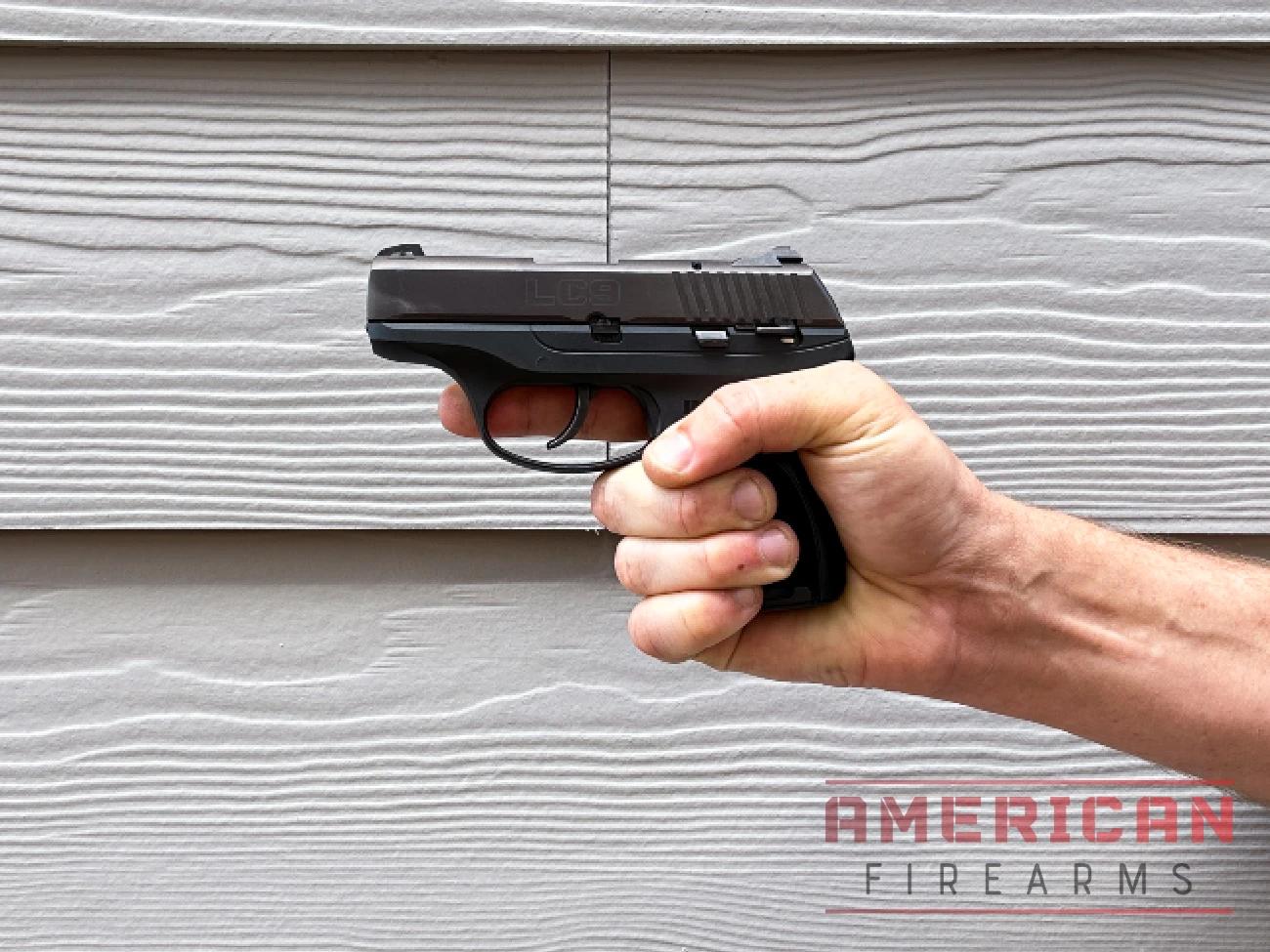
While it’s true that smaller guns can be easier to conceal, they aren’t automatically the best choice. For one, tiny pistols can be difficult to draw. The shorter the slide, the smaller the grip, and the more they ride along your beltline, giving no room to get your fingers around it.
Also, tiny pistols can be uncomfortable to carry. I know, I know, but hear me out. Shorter slides don’t leave much surface area below the belt, which causes your body to push the top of the gun. In other words, tiny guns tend to tip over the top of the belt, making it very uncomfortable.
Training and Safety Recommendations
When I first started carrying, I thought buying a gun was the hard part. Turns out, that was just the beginning. The real work starts after you walk out of the gun store. No matter how perfect your new pistol feels in your hands, it’s an expensive (and possibly dangerous) paperweight without proper training and a solid understanding of firearms safety.
I learned this lesson the hard way during my first trip to the range with a brand-new carry gun years ago. I was so focused on hitting the target that I completely forgot about my grip, stance, and breathing.
After burning through two boxes of ammo with embarrassing results, the range safety officer – a retired police sergeant – pulled me aside. “Ma’am,” he said kindly, “you’ve got a fine pistol there, but you’re fighting it instead of working with it.” That conversation changed everything.
The Four Fundamental Rules
Before we talk about anything else, let’s cover the foundation: the four fundamental rules of firearm safety. These aren’t suggestions – they’re non-negotiable principles that every gun owner must internalize.
Rule 1: Treat every firearm as if it’s loaded. Even when you “know” it’s empty, even when you just checked it five seconds ago. This mindset prevents the kind of complacency that leads to accidents.
Rule 2: Never point the muzzle at anything you don’t intend to destroy. Your gun should always be pointed in a safe direction – typically downrange at the shooting range or toward the ground when handling at home.
Rule 3: Keep your finger off the trigger until you’re ready to shoot. That finger belongs on the frame, not the trigger guard, until you’ve made the conscious decision to fire.
Rule 4: Know your target and what’s beyond it. Bullets don’t stop just because they hit their intended target. You’re responsible for every round that leaves your barrel.
Getting Professional Training
Here’s something that might surprise you: most of the best female shooters I know didn’t start out as “naturals.” Take Lena Miculek, daughter of legendary shooter Jerry Miculek and a world champion in her own right. She’s been vocal about the importance of proper instruction from the beginning. “Good habits are just as hard to break as bad ones,” she often says, “so you might as well start with good ones.”
Look for instructors who understand that women often learn differently than men. We tend to be more analytical and want to understand the “why” behind each technique. A good instructor will explain not just what to do, but why you’re doing it. Organizations like A Girl & A Gun offer women-only classes that create a comfortable learning environment where you can ask questions without feeling judged.
I recommend starting with a basic pistol course that covers grip, stance, sight alignment, and trigger control. These fundamentals are the building blocks of everything else. Once you’re comfortable with the basics, consider defensive shooting courses that teach real-world scenarios like shooting from cover or drawing from concealment.
Practice Makes Permanent
Professional shooter Julie Golob, a former U.S. Army Marksmanship Unit member and current Smith & Wesson sponsored athlete, emphasizes that practice doesn’t make perfect – practice makes permanent. If you’re practicing bad habits, you’re just reinforcing them.
Dry fire practice at home is invaluable and completely safe when done correctly. Always double and triple-check that your gun is unloaded, remove all ammunition from the room, and practice your grip, sight alignment, and trigger press. Even five minutes of dry fire practice several times a week will improve your shooting more than an occasional trip to the range.
When you do get to the range, quality beats quantity every time. It’s better to shoot 50 rounds with focused attention than 200 rounds just punching holes in paper. Keep a shooting journal – I know it sounds nerdy, but tracking what you’re working on and what’s improving helps accelerate your progress.
Building the Right Mindset
Carrying a gun isn’t just about having the physical ability to use it – it’s about developing the mental preparedness to make life-and-death decisions under extreme stress. This is where scenario-based training becomes crucial. Many ranges now offer force-on-force training with simulated ammunition that puts you in realistic situations where you have to decide whether to shoot or not.
Col. Jeff Cooper, who developed the modern technique of pistol shooting, created the Color Code system that many instructors still teach today. It’s a way of maintaining situational awareness: White (unaware), Yellow (relaxed alert), Orange (specific alert), and Red (fight mode). Learning to live in Condition Yellow – aware of your surroundings but not paranoid – is a skill that benefits every aspect of your life.
Ongoing Education
The firearms world is constantly evolving, and what worked ten years ago might not be the best practice today. Stay connected with the shooting community through local clubs, online forums, and continuing education courses. Many manufacturers offer training courses specific to their firearms – Glock, for instance, has an excellent armorer’s course that teaches you how to completely disassemble and maintain your pistol.
Remember, the goal isn’t to become Annie Oakley overnight. It’s to develop competence and confidence with your chosen firearm. Start with solid fundamentals, practice regularly, and never stop learning. Your future self – and anyone who might depend on your ability to protect them – will thank you for putting in the work.
As that range safety officer told me years ago, “The gun is just a tool. The real weapon is between your ears.” Make sure both are properly trained and ready when you need them most.
Closing Thoughts
When I purchased my first concealed carry handgun, I handled it briefly but didn’t shoot it first. I was new to the concealed carry world and picked the smallest 9mm I could find. Turns out I hated it and never practiced. I learned a few expensive lessons through that experience which you can easily avoid.
Over a decade later, I rotate between my Glock 48 MOS and Glock 43, depending on the weather and outfit choice. I took my time choosing them and haven’t regretted either purchase. I love both pistols and practice regularly.
Remember we talked about compromise with concealed carry earlier? If I had my choice, my Walther PDP-F would be my daily self defense carry, but it’s too large for my frame.
Finding the right concealed carry weapon is like finding the right partner, and you just know. Ok, maybe it’s not that serious, but it is a big decision that you should put some thought into. There are so many great choices out there that you’ll surely find one you love. The list here is not exhaustive, but it should give you some ideas on where to start looking.
Updated
Sign up for our newsletter
Get discounts from top brands and our latest reviews!





